Scenic trains, views of Mount Fuji, hot springs, an active volcano and a pirate ship – visiting Hakone and doing the Hakone round trip is a must for your trip to Japan! In this post I’ll explain why you should add Hakone to your Tokyo itinerary, how to get around the Hakone loop and what to see on the way.
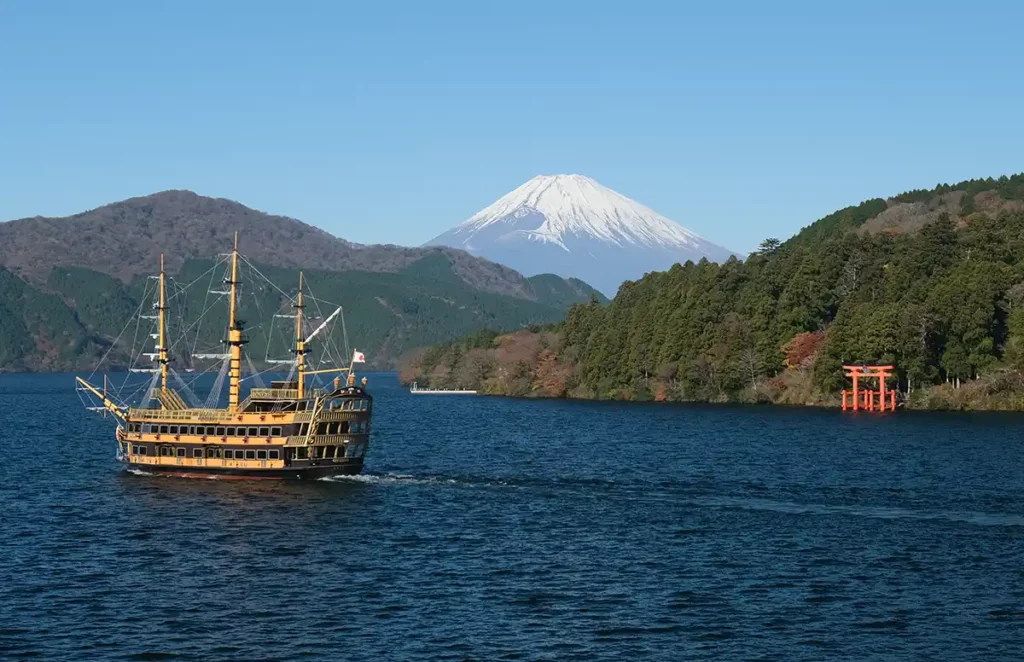
Why visit Hakone?
A trip to Hakone is the perfect way to see some of the beautiful countryside just outside Tokyo. Whether you visit Hakone as a day trip from Tokyo or stay overnight in a relaxing onsen hotel, you won’t regret adding Hakone to your Tokyo itinerary.
The wonderful thing about visiting Hakone is that there’s so much to see, and the whole area is really well geared up for visitors. It is touristy, but the whole experience is so much fun. Where else on earth could you see Mount Fuji, sail on a pirate ship, eat an egg cooked in a volcano and relax in a hot spring bath, all in one day?
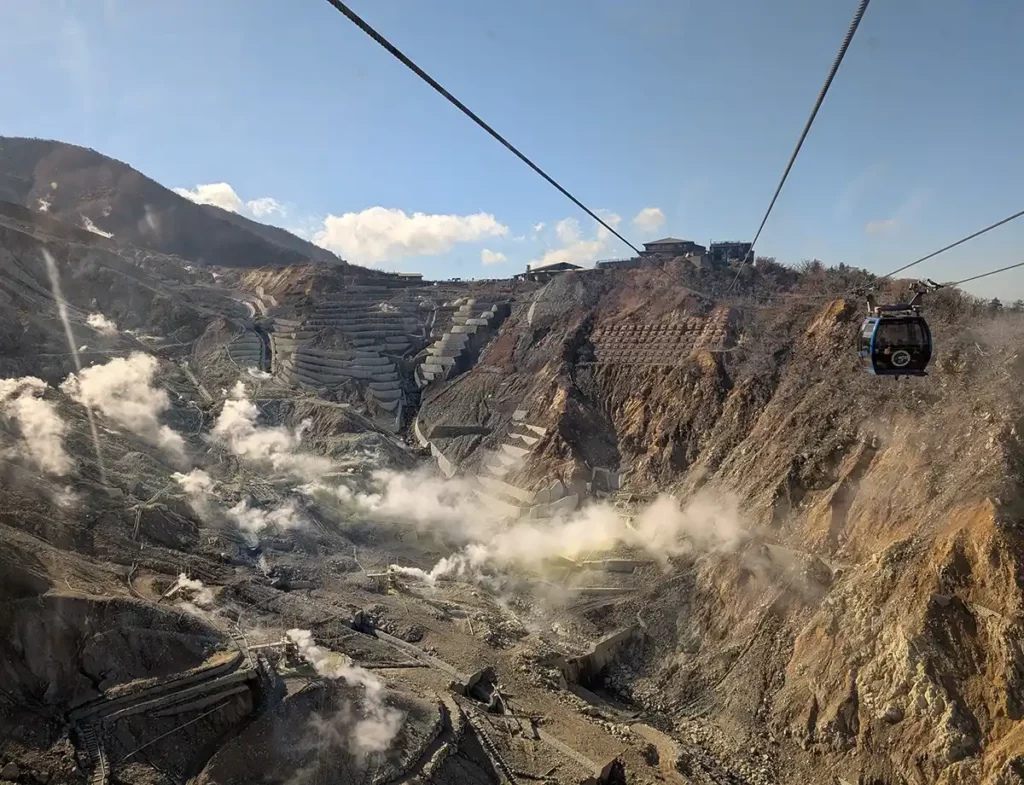
Where is Hakone?
Hakone is an area rather than a single destination. The gateway to Hakone is Hakone-Yumoto, a small town around 50 miles south west of Tokyo with direct train connections to Shinkuju.
From Hakone-Yumoto, most visitors will do at least part of the Hakone sightseeing loop; a round trip that looks complicated but is actually very easy to follow in practice.
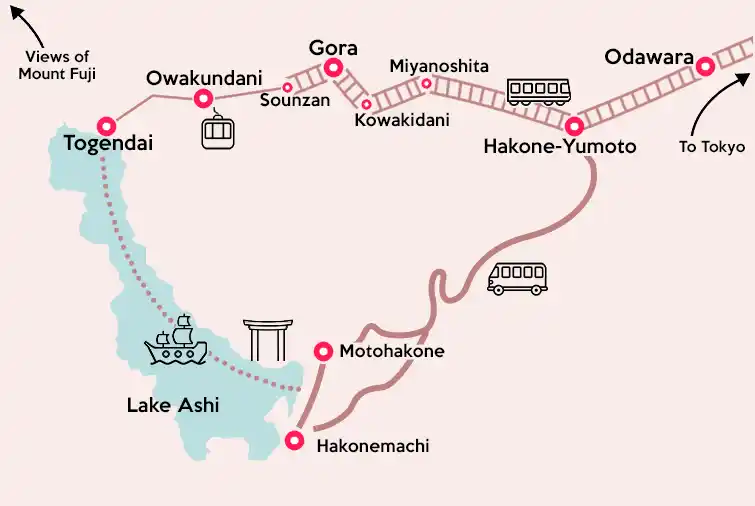
The Hakone loop – an easy round trip
The Hakone sightseeing loop can be done as a day trip from Tokyo and includes:
- a train ride on a mountain railway
- a cable car over a steaming volcano
- a pirate ship boat ride
- incredible views of Mount Fuji (if the weather is clear)
- the chance to have your picture taken at the Hakone shine’s beautiful lakeside torii gate
- adding 7 years to your life by eating a black egg that’s been cooked in a volcano
I loved my trip to Hakone from Tokyo and would recommend it to anyone, especially if you’ll be spending the rest of your time in Japan in cities or if you’ve got limited time in Japan. You’ll pack so much in over just a day or two, and the whole experience is so much fun – especially if Fuji-san shows itself!
How to get to Hakone
From Shinjuku
If you’re staying in Shinjuku, the easiest way to get to Hakone is to buy the Hakone Freepass at Shinjuku Station. Your train ticket from Shinjuku to Odawara, then Odawara to Hakone-Yumoto is included in this version of the Hakone Freepass.
To get to Hakone around 30 minutes quicker and without needing to make any changes, upgrade to the Romancecar. This amusingly-named limited express train makes the journey from Shinjuku to Hakone-Yumoto in just under 90 minutes (and yes, it’s suitable for everyone, including kids, it’s not just for couples!)
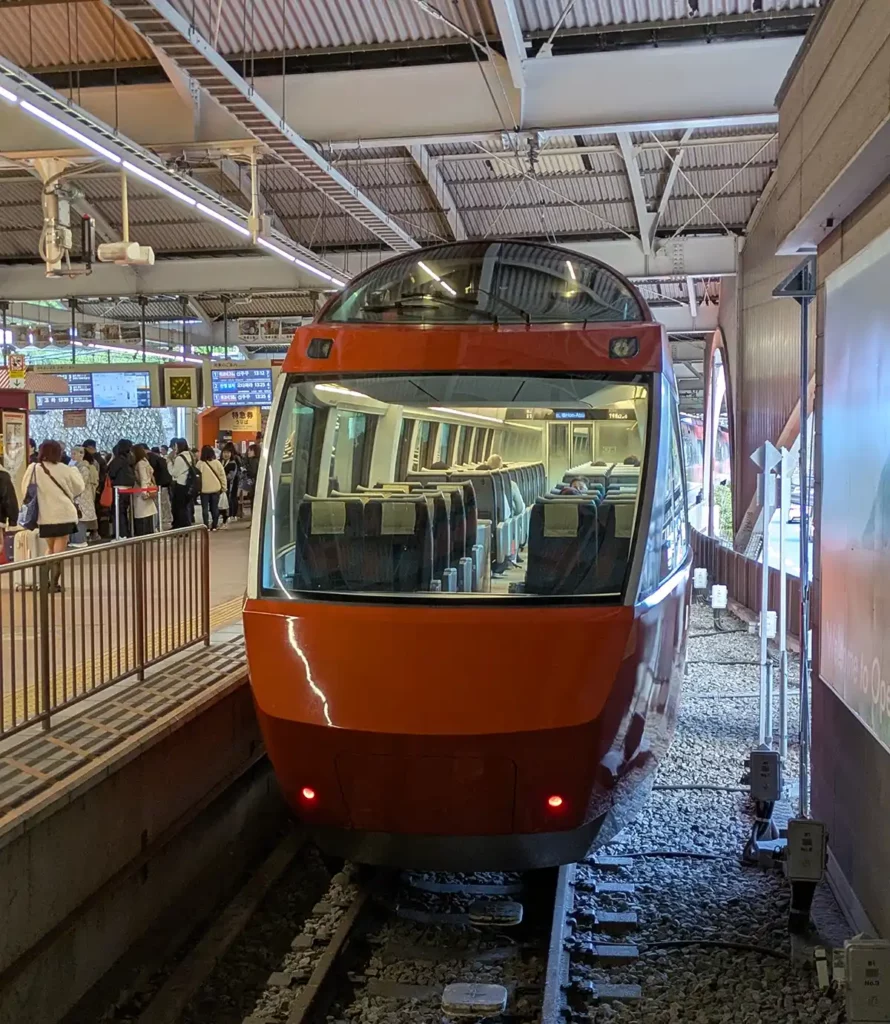
From Tokyo Station
Another option is to take the Shinkansen bullet train from Tokyo Station to Odawara, buy your Hakone Freepass at Odawara Station then take a local train from Odawara to Hakone-Yumoto to start the sightseeing loop.
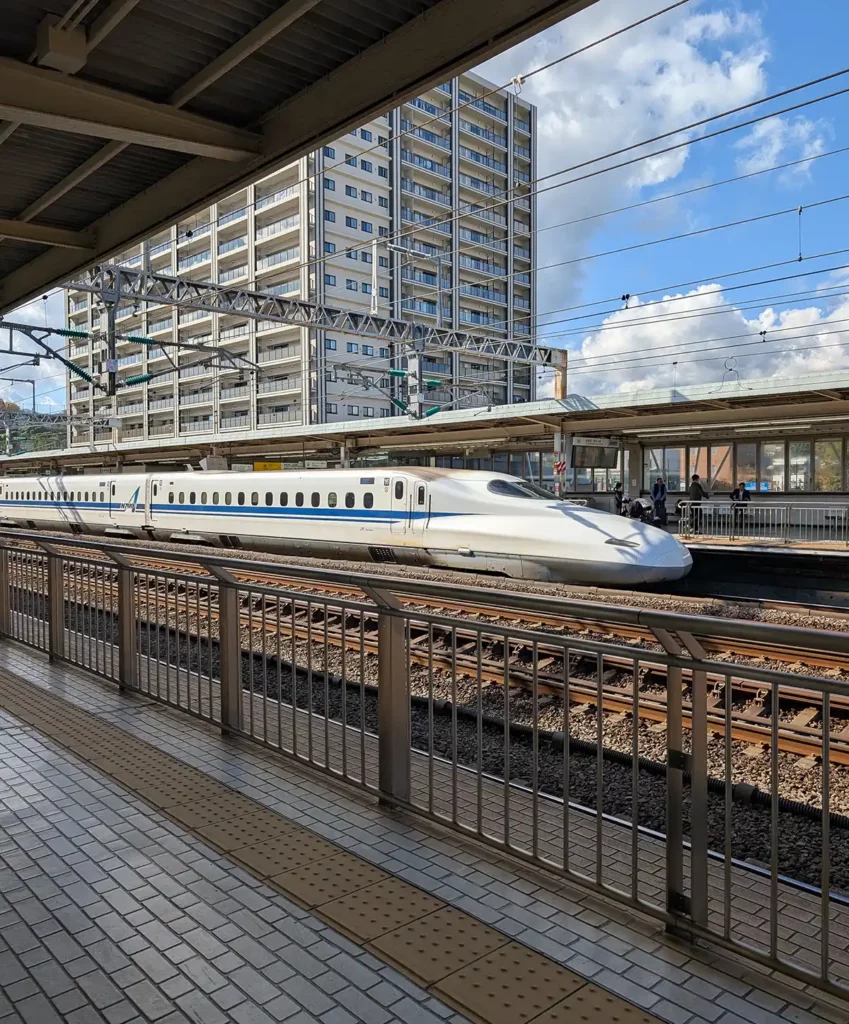
Taking the Shinkansen from Tokyo Station to Odawara, then a local train to Hakone is a great option for an easy day trip by bullet train from Tokyo. Even though I was staying in Shinjuku, I was desperate to experience the Shinkansen during my Japan trip, so we took the bullet train to get to Hakone and travelled on the Romancecar back to Shinjuku.
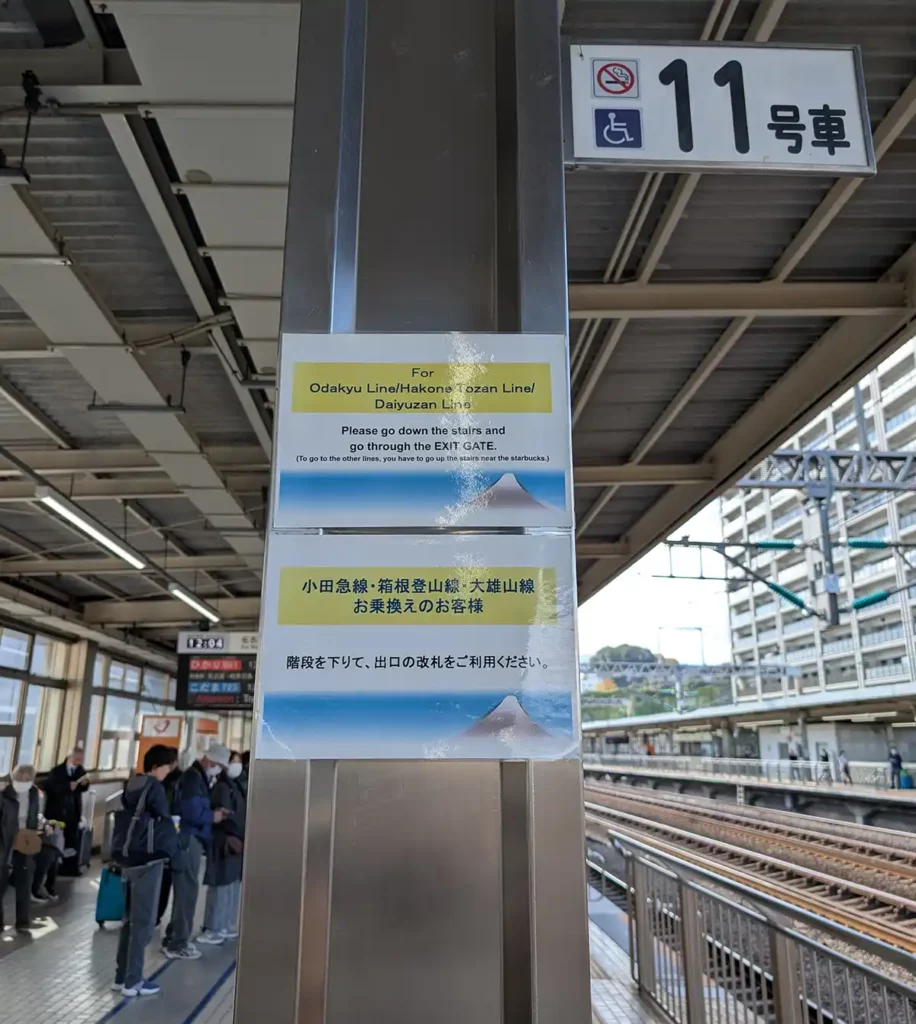
The connection at Odawara was really easy, with signs everywhere directing us to the platforms for Hakone.
The Hakone sightseeing pass – Hakone Freepass
One of the reasons it’s so easy to pack so much into a trip to Hakone is that all the transport you’ll need is included in the Hakone Freepass – a sightseeing pass which also includes discounts at the attractions along the way.
There are two versions of the pass; one which includes transport to and from Tokyo (more on that in a minute) and a cheaper version which only includes transport in the Hakone area which you can buy at Odawara Station.
It’s easy to buy as either a physical ticket or a digital version, and so easy to use – you literally just flash it whenever you want to get on a train, cable car, bus or pirate ship.

How to buy the Hakone Freepass
Before you buy your Hakone Freepass, you’ll need to decide:
- how you want to get to Hakone. Will you take the regular train from Shinjuku which is included in the pass, will you want to pay the supplement to take the express Romancecar train, or will you get there in another way?
- how long you expect to spend in Hakone. There are 2 or 3 day versions of the pass. There’s no version for just one day.
- whether you want the physical or digital version of the pass. If you choose the digital version, everyone who has a pass will need their own smartphone to display it on.
If you want the digital version of the pass, you can buy it online from the Odakyu Railways website or from Klook.
If you want a physical ticket version of the pass, you can buy it from the Odakyu Sightseeing Service Centres in Shinjuku and Odawara. The service centre in Shinjuku Station is near the West Gate.
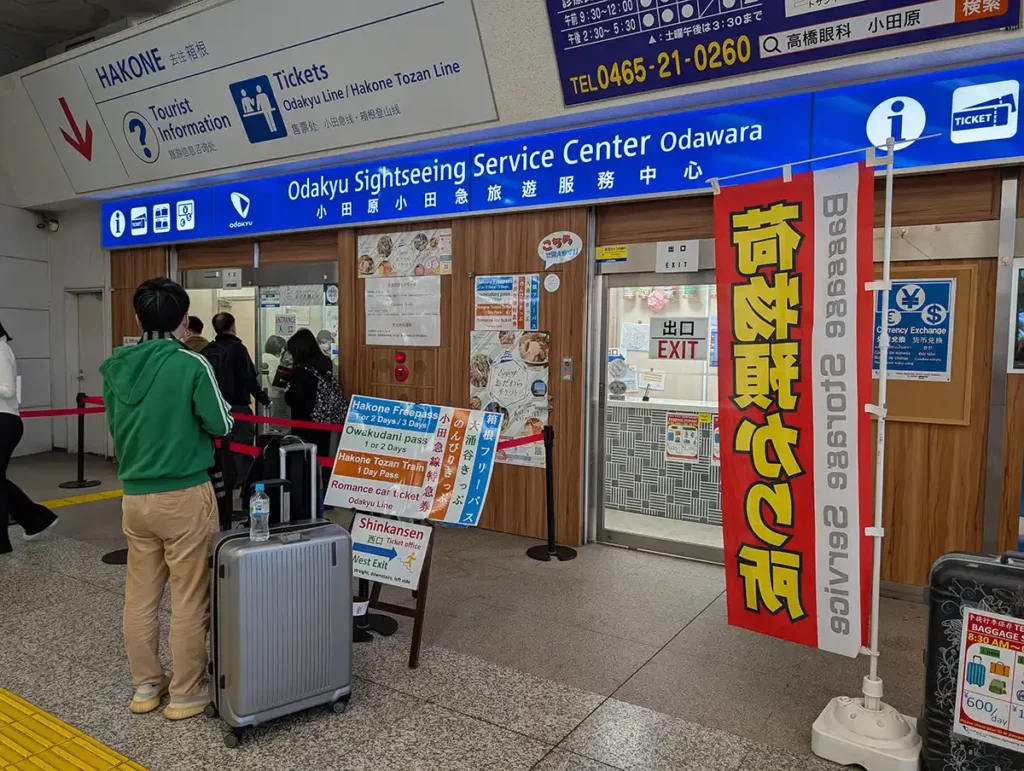
How much does the Hakone Freepass cost?
Pass with travel from Tokyo
The version of the pass which includes a round trip ticket from Tokyo costs 6,100 yen for adults and 1,100 yen for children for a 2 day pass, and 6,500 yen for adults and 1,350 yen for children for a 3 day pass.
If you want to travel on the Romancecar limited express, you’ll need to buy a supplement ticket. You can do this either at Odakyu ticket offices or online. The Romancecar supplement costs 1,150 yen if you book it online and 1,200 if you buy it in person. Remember that you’ll need both a Hakone Freepass (or a regular ticket) and a limited express supplement ticket to take the Romancecar!
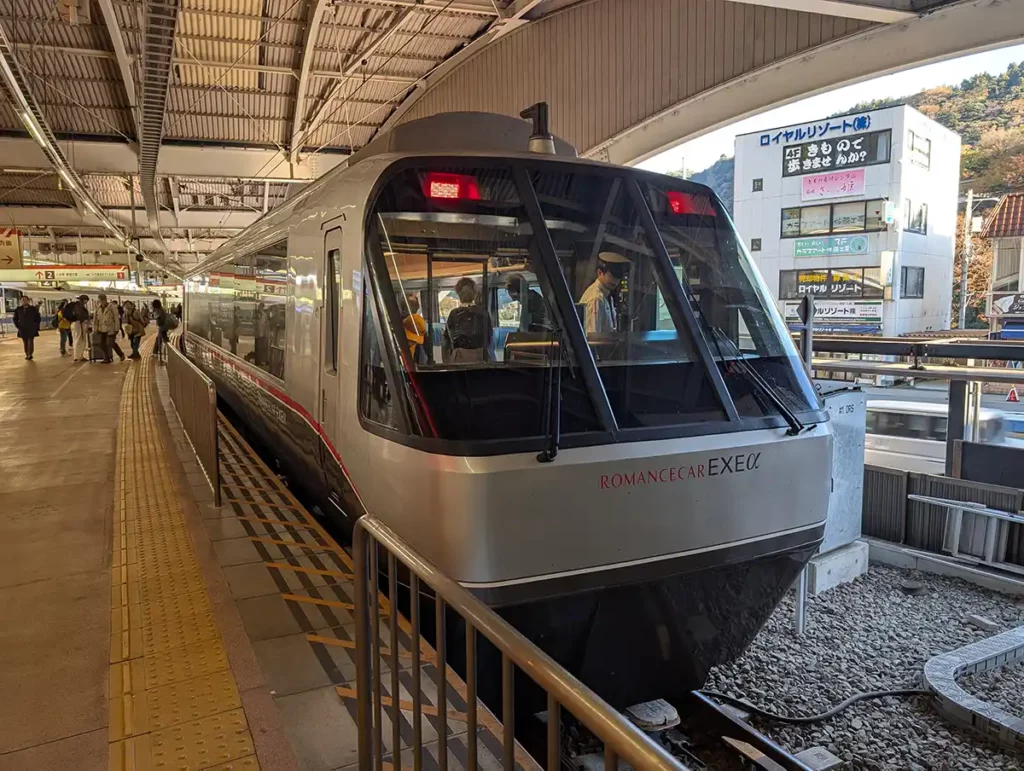
Pass for Hakone area only
The version of the pass which only includes the Hakone area and Odawara to Hakone costs 5,000 yen for adults and 1,000 yen for children for a 2 day pass, and 5,400 yen for adults and 1,250 yen for children for a 3 day pass.
Is the Hakone Freepass cheaper than buying individual tickets?
Yes, most people will save money by buying the Hakone Freepass rather than individual tickets to each form of transport on the Hakone sightseeing loop.
The Hakone sightseeing loop: clockwise or anticlockwise?
You can do the Hakone sightseeing loop in either direction. If you do it clockwise, you’ll start with a bus ride from outside Hakone-Yumoto station to Lake Ashi. If you do it counter-clockwise, you’ll start with the Hakone Tozan mountain railway ride to Gora.
The most popular direction for the Hakone loop is counter-clockwise, and you’ll see people arriving on the Romancecar dashing for the Hakone Tozan railway platform on the opposite side of the station.
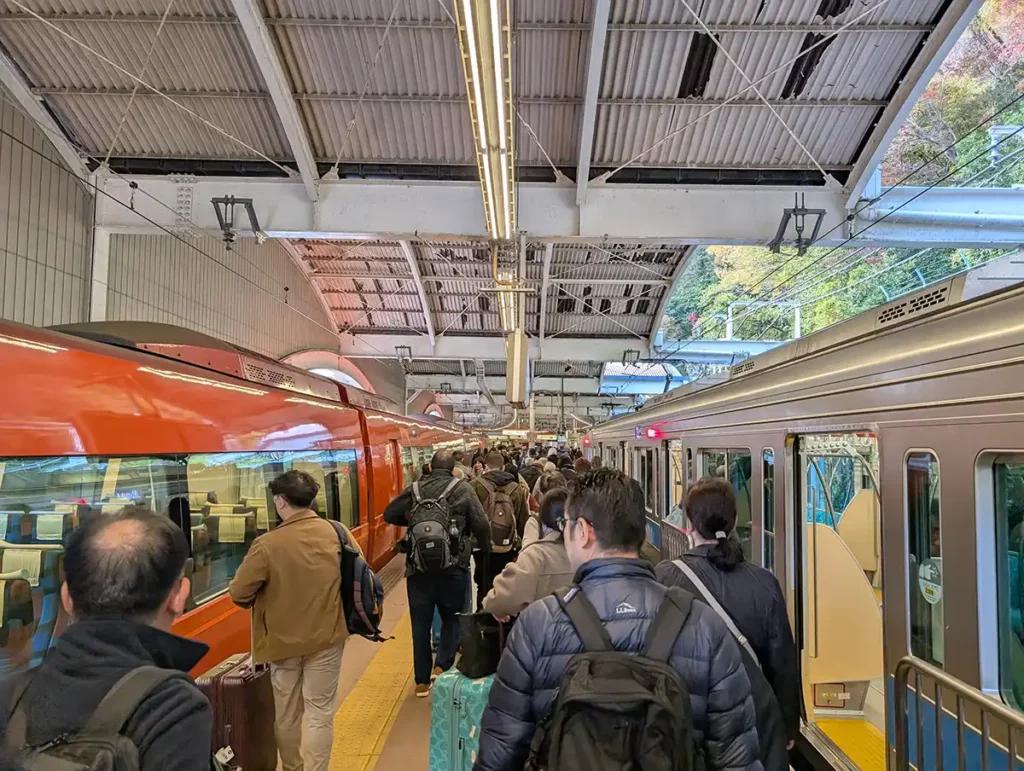
We were staying overnight in an apartment next to Lake Ashi and it worked out best for us to travel clockwise around the loop. It did seem a little quieter than travelling in the other direction; the boats, trains and cable cars we saw heading the other way did seem busier than the ones we were on.
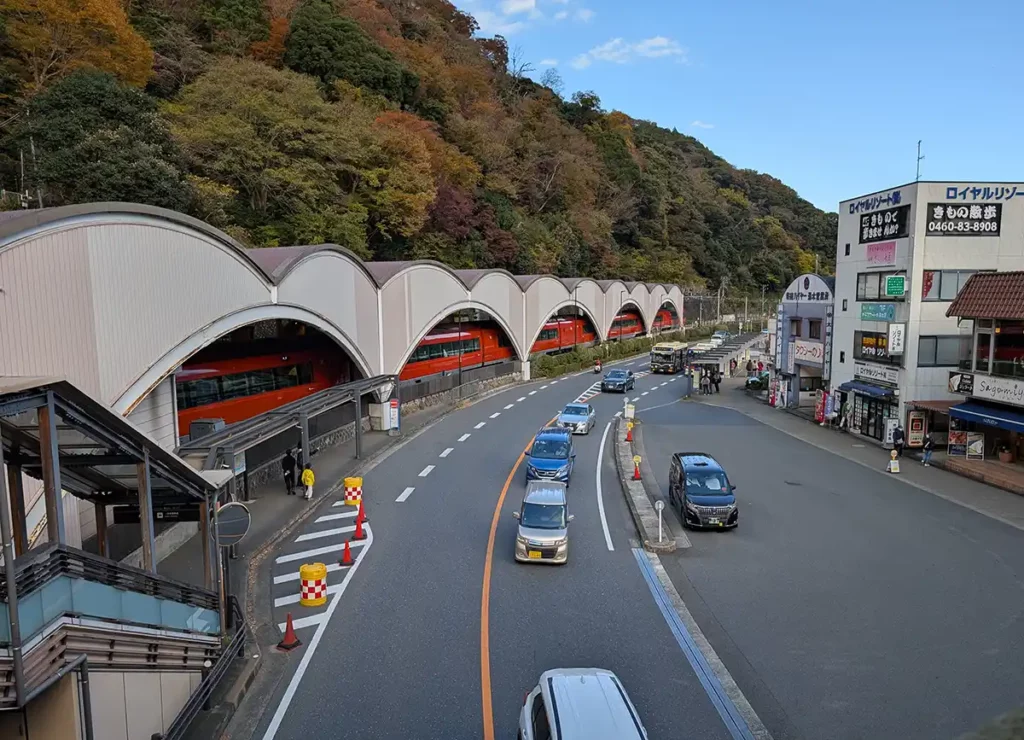
The rest of this post is written from the perspective of someone doing the Hakone loop clockwise, as that’s the way we went. Travelling in the other direction wouldn’t be significantly different, and with the exception of the bus trip, it’s very easy to understand where you’re meant to go next.
Travelling clockwise on the Hakone sightseeing loop: step by step
Each part of the journey on the Hakone loop has its own charm, and each place you arrive at has something special to see. For each step of the journey I’ll give you an overview of how to get there and what you can see.
Hakone-Yumoto to Motohakone on Lake Ashi by bus
From Hakone-Yumoto station, you’ll need to take a bus to Motohakone on the edge of Lake Ashi. There are two buses that you can take, the R and K lines. Of these, the K line runs much more frequently.
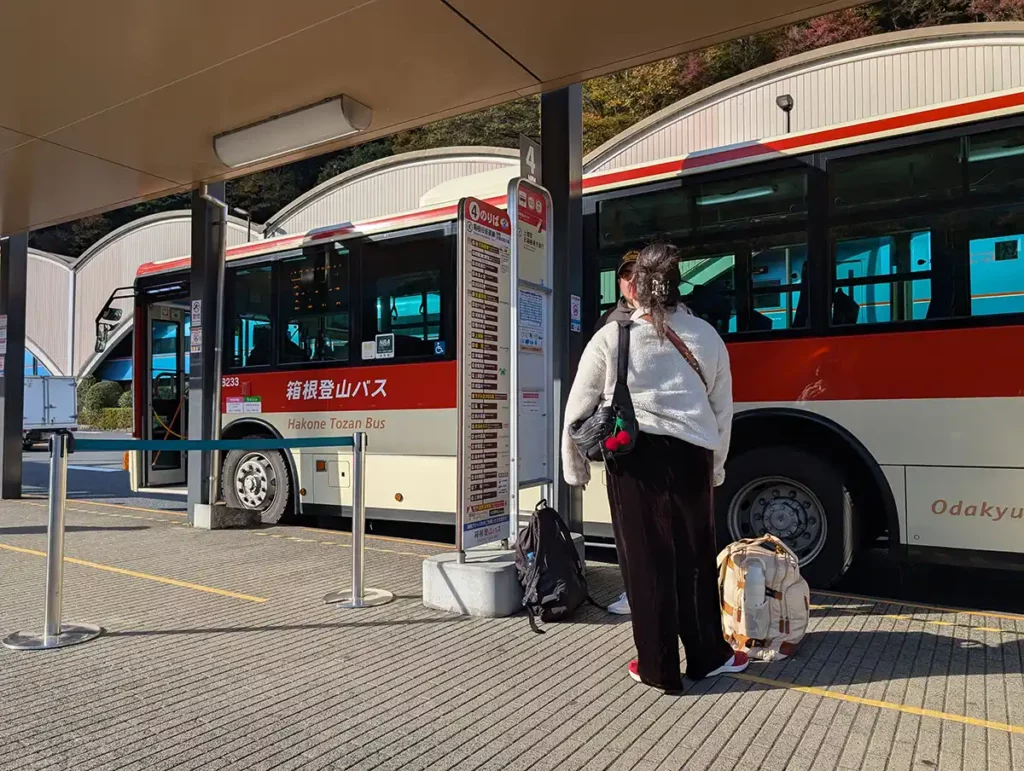
I caught the bus with the winding route. If you get travelsick then I’d recommend taking the other one, but it was so pretty and I loved seeing the tiny villages as we headed up the mountain.
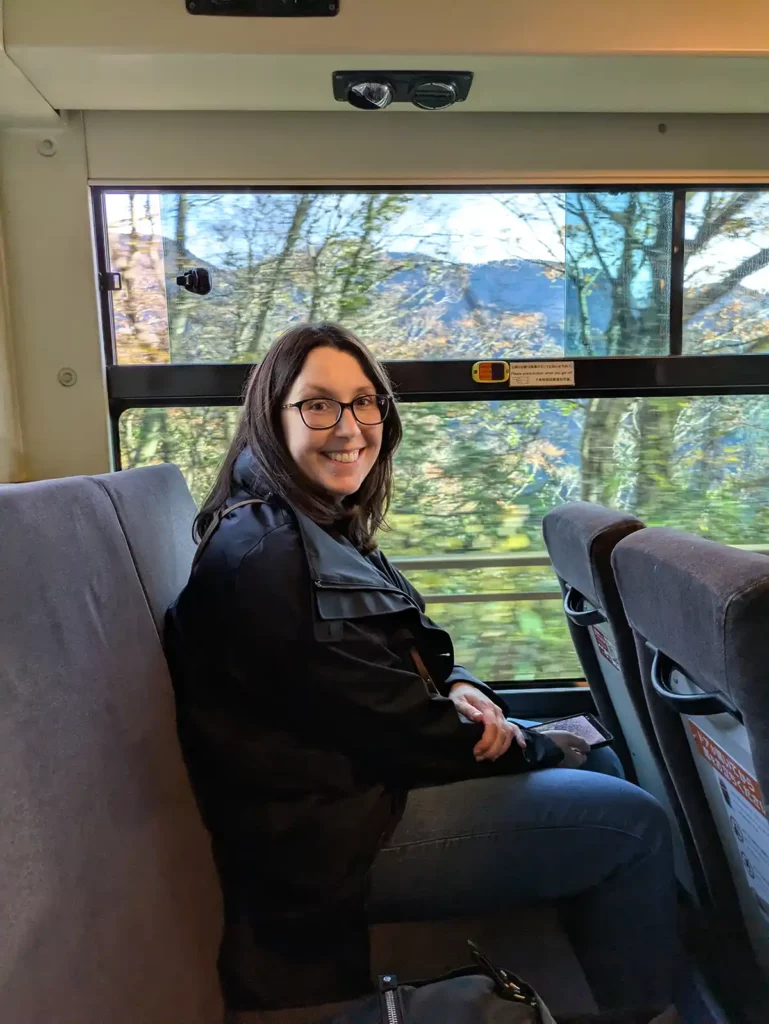
The bus we took was quite small and although the one I took wasn’t too full, I have seen photos of packed buses and people standing for the journey. I’d recommend making your way to the bus stop and queueing up well before the bus is due to depart to be sure of getting a seat.
The bus arrives at a bus station on the edge of Lake Ashi, opposite the port for the pirate ship, making the connection really easy.
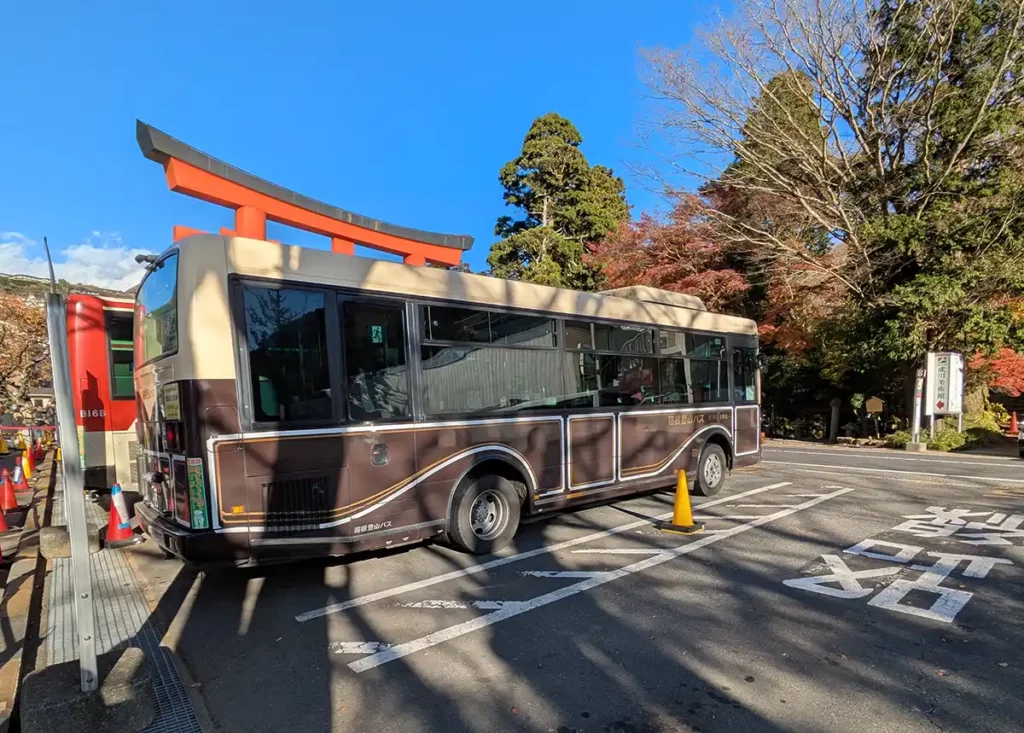
Things to do in Motohakone
Visit Hakone Shrine and the lakeside torii gate
One of the most popular places to visit on Lake Ashi is Hakone Shrine’s beautiful red torii gate, which has a gorgeous setting in the water on the edge of the lake. The torii is around 10-15 minutes’ walk from the bus stop along a lakeside path.
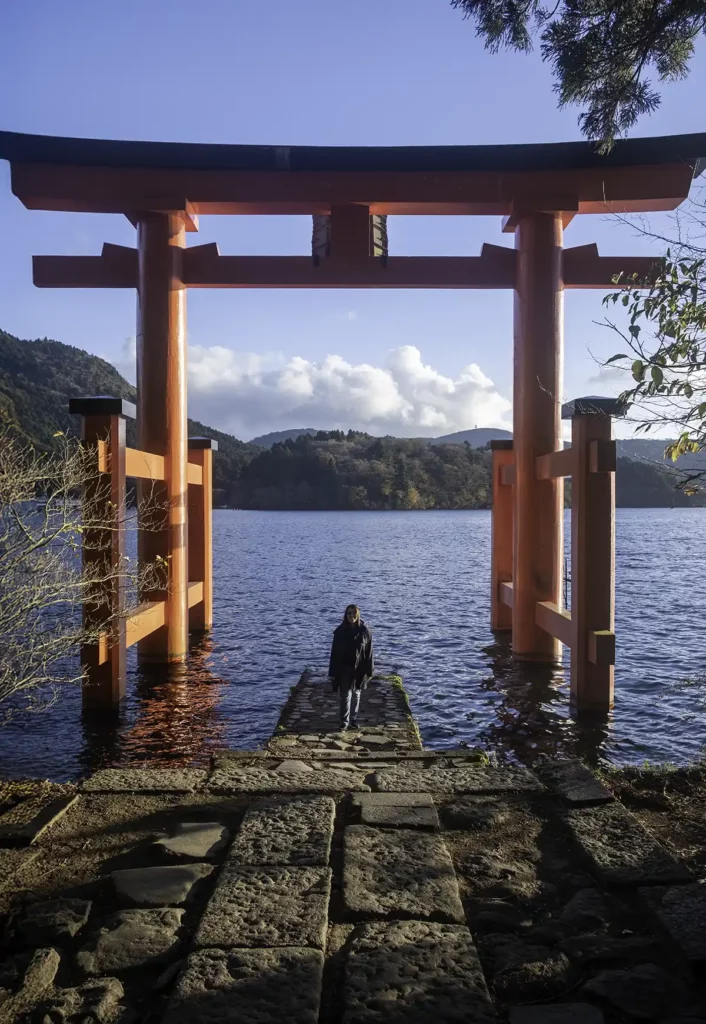
It’s a hugely popular Instagram spot, and when you visit you’re almost certain to find a long queue to take *the* photo. I waited around 50 minutes but I’ve seen people reporting that the queue can take hours.
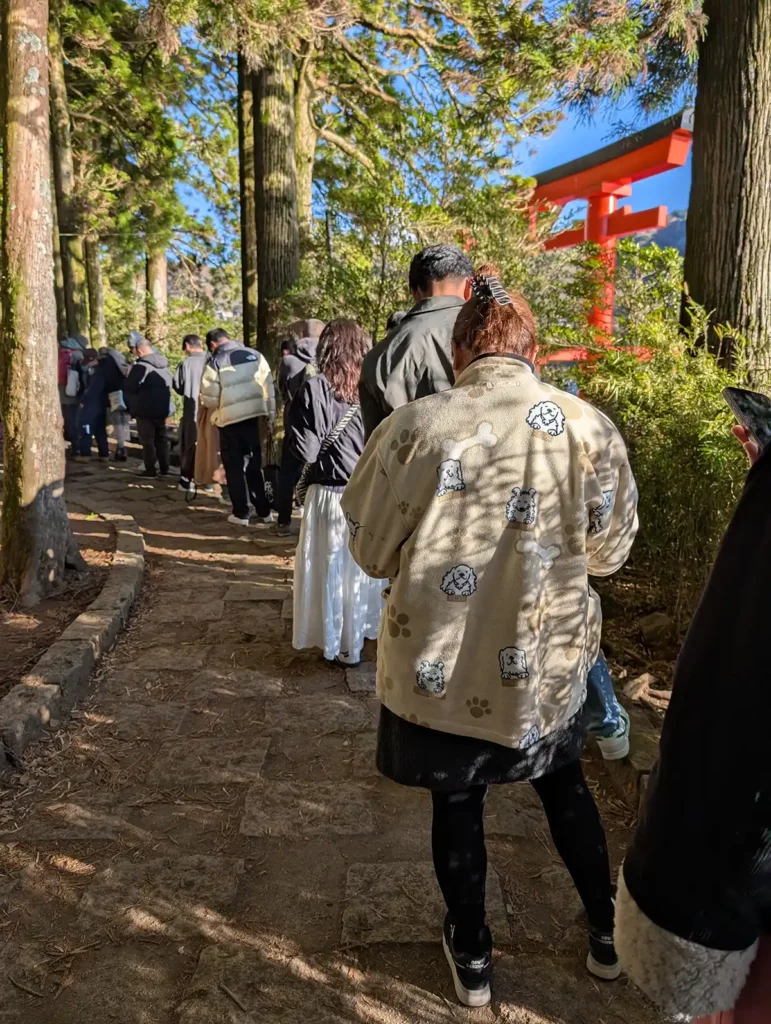
The shrine leaders don’t seem terribly happy about their torii gate’s fame, and there are warnings that if people don’t respect the rules or the shrine, then they’ll stop people being able to take photos there.
Once you reach the front of the queue, you’ve got 3 minutes to get a shot. We found that the people behind us in the queue were happy to help us take a photo together.
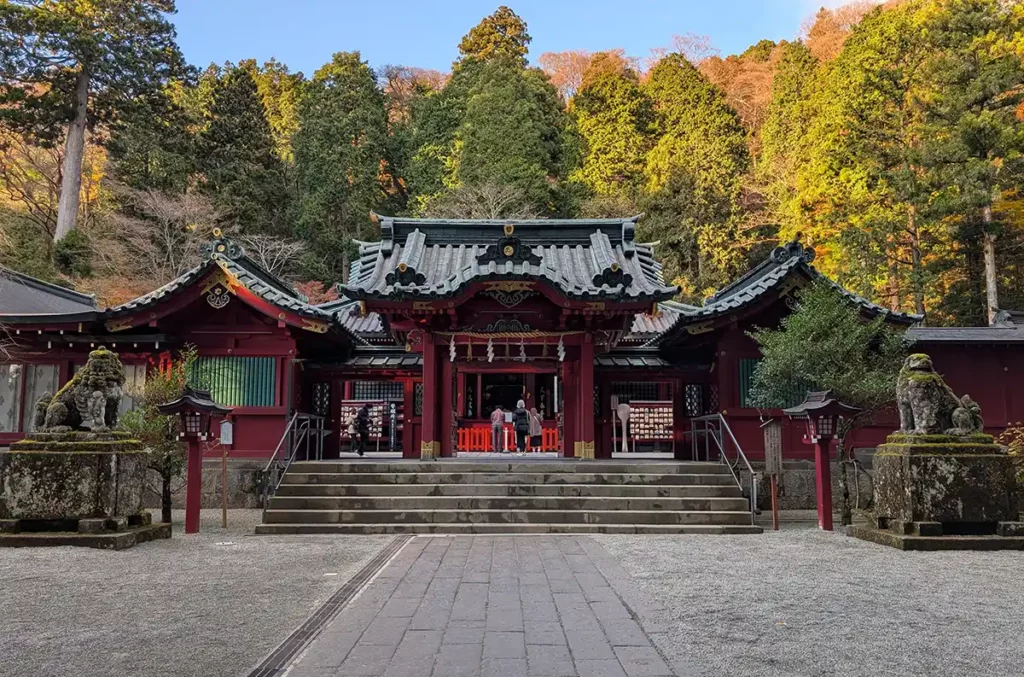
Once you’ve taken your photo, make sure you visit the shrine itself. It’s up a lot of steps from the lake, but its setting in the woods was so pretty.
Views of Mount Fuji
I’d already fallen in love with Motohakone, but when we were walking back from the shrine to check in to our hotel, we noticed loads of people a little further round the lake with their cameras and phones out. When we got there, we realised that Mount Fuji was in full view across the lake, with a perfect snow-capped peak.
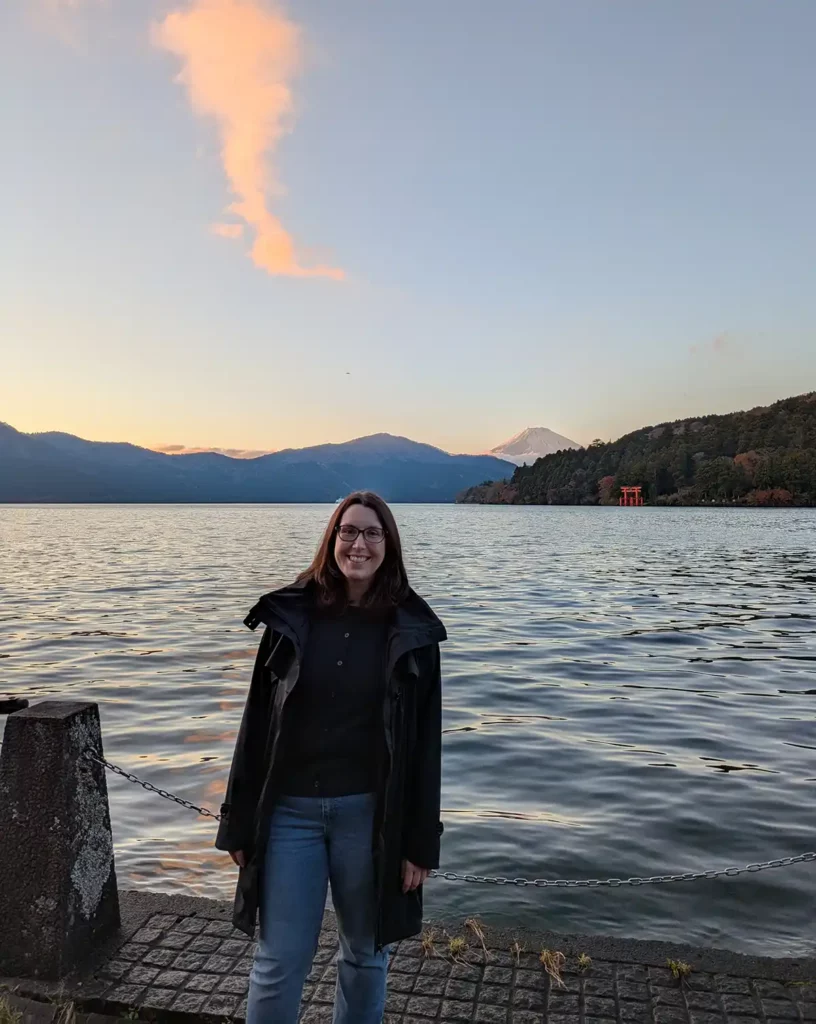
I’d seen Fuji from the plane on our flight to Tokyo, but seeing it properly I honestly gasped, it was so beautiful. I was even more delighted when I realised that our hotel would have the same view!
Read more: Rakuten Stay Fujimi Terrace review – a private onsen apartment with amazing Fuji views
Narukawa Art Museum
The Narukawa Art Museum showcases a small but well-curated collection of modern Japanese art. The café has a wonderful view across the lake towards Mount Fuji (on a clear day).
Old Tōkaidō Road Ancient Cedar Avenue
Motohakone sits on the ancient Tōkaidō Road which linked Kyoto to Edo (modern-day Tokyo) during the Edo period (1603 to 1868). This section is one of the few remaining stretches of the old road; it’s now a peaceful path between enormous cedar trees.
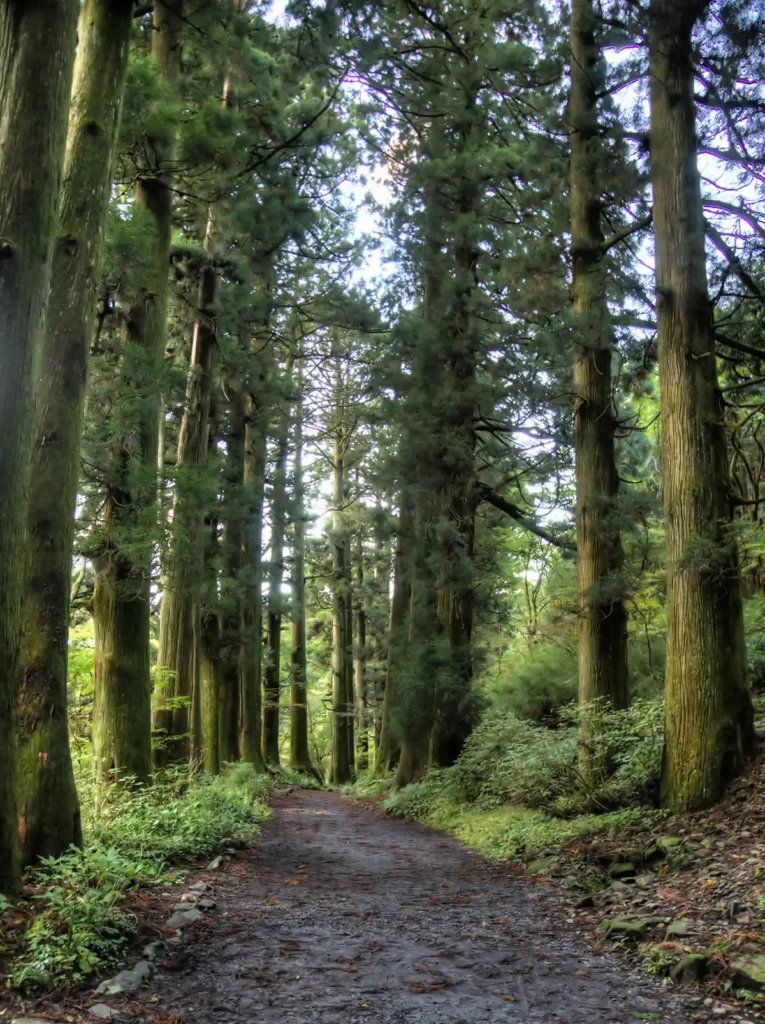
You can either walk just a short stretch, or if you want to go a little further, you can follow it uphill to the atmospheric Amasake Tea House.
Onshi-Hakone Park
This park on a little peninsula sticking out into Lake Ashi is full of hiking trails and has lovely viewpoints where you can see the lakeside torii gate and maybe Mount Fuji.
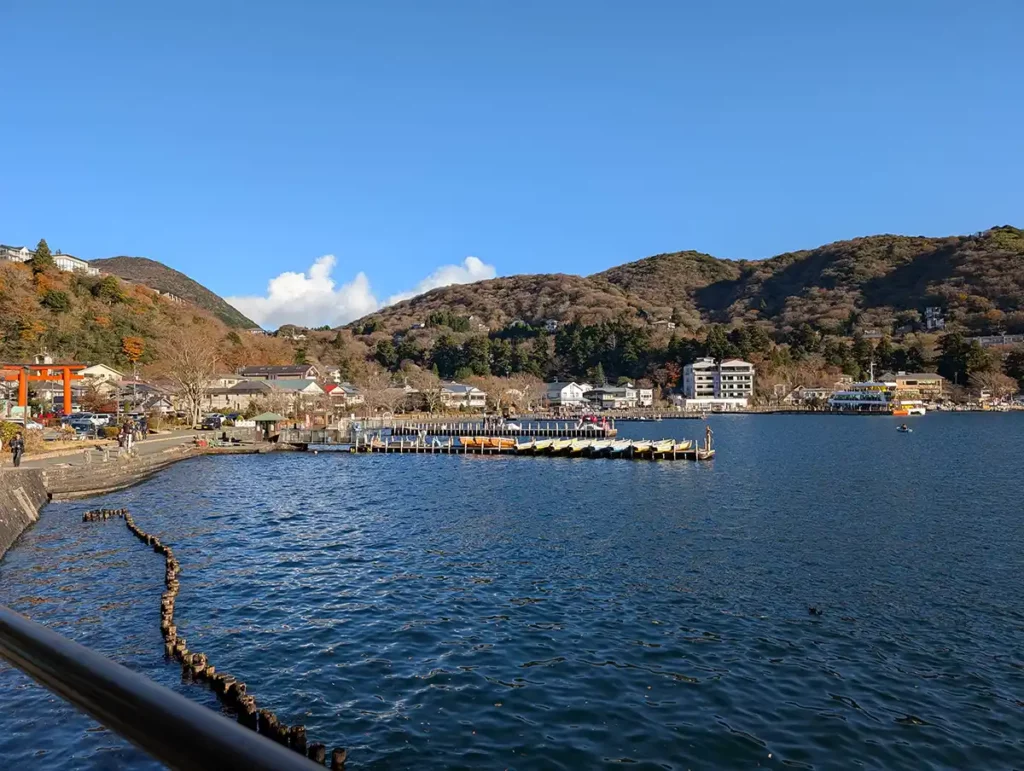
Hakone Checkpoint and Museum
Another relic of the Edo era when Hakone was on the old Tōkaidō Road, this reconstructed security checkpoint helps visitors to imagine what it was like to visit Hakone hundreds of years ago.
Motohakone to Tōgendai by pirate ship
This was one of my favourite parts of the Hakone loop – like so many things in Japan it’s completely mad but so perfect. I genuinely couldn’t stop laughing as we queued up to take a pirate ship across an inland lake towards Mount Fuji!
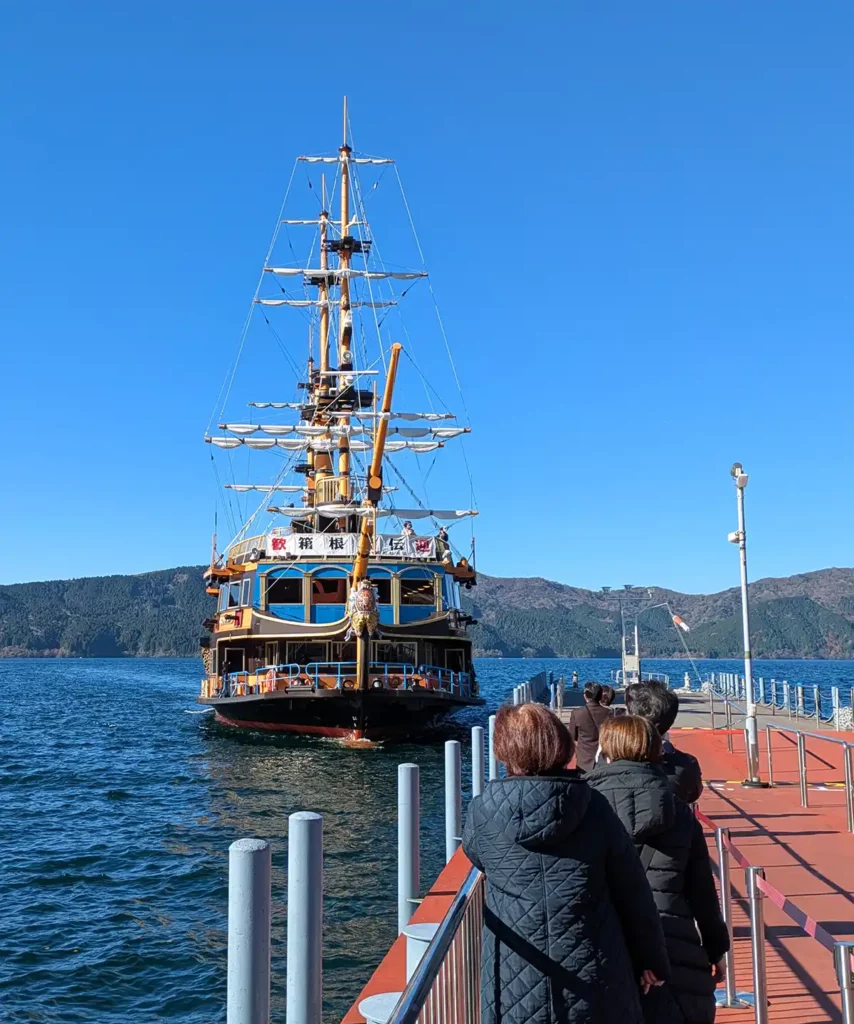
The pirate ship boat ride across Lake Ashi is included in the Hakone Free Pass. Boats depart from the port next to the bus station and depart regularly, so making your connection for the next part of your journey is really easy.
If you want to take the experience a step further, you can upgrade to first class for 700 JPY, which gives you priority boarding and access to the decks at the front of the ship. I upgraded, and it was nice to have lots of space, but I don’t think it was really necessary.
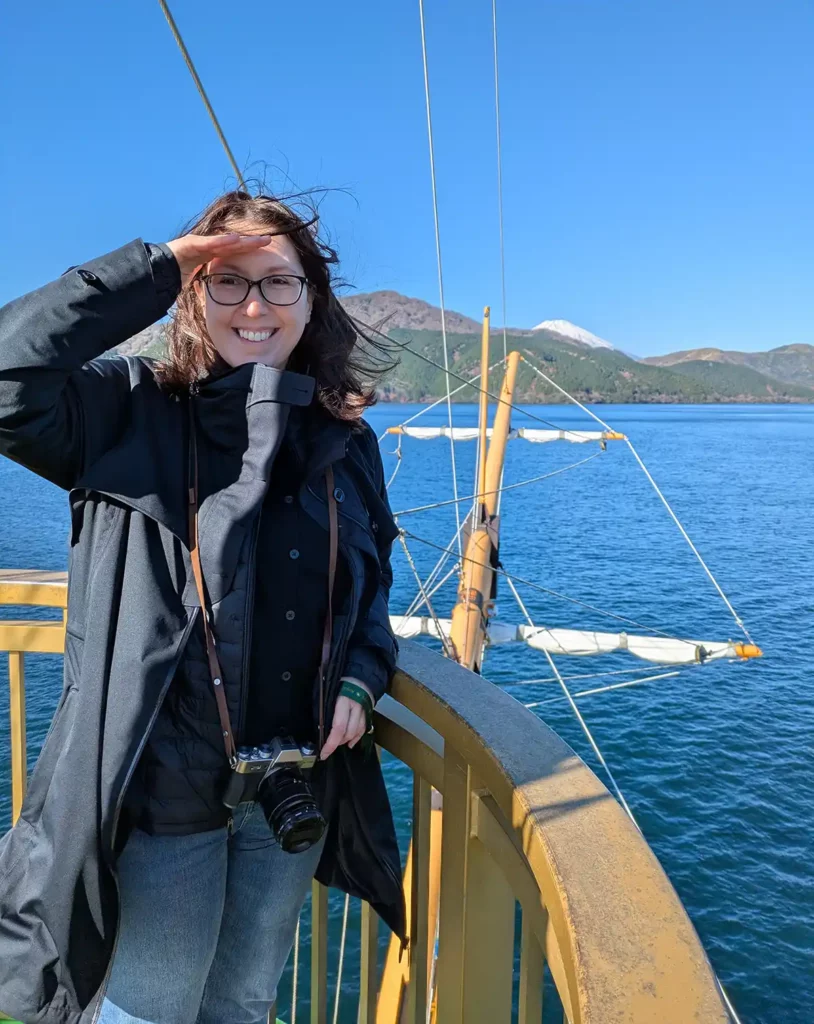
The cruise across Lake Ashi from Motohakone to Tōgendai takes around 25 minutes. It sails past the Hakone Shrine’s torii gate, forests and lakeside hotels and it’s very pretty, even if you don’t get Mount Fuji views. There are toilets and a small cafe on board.
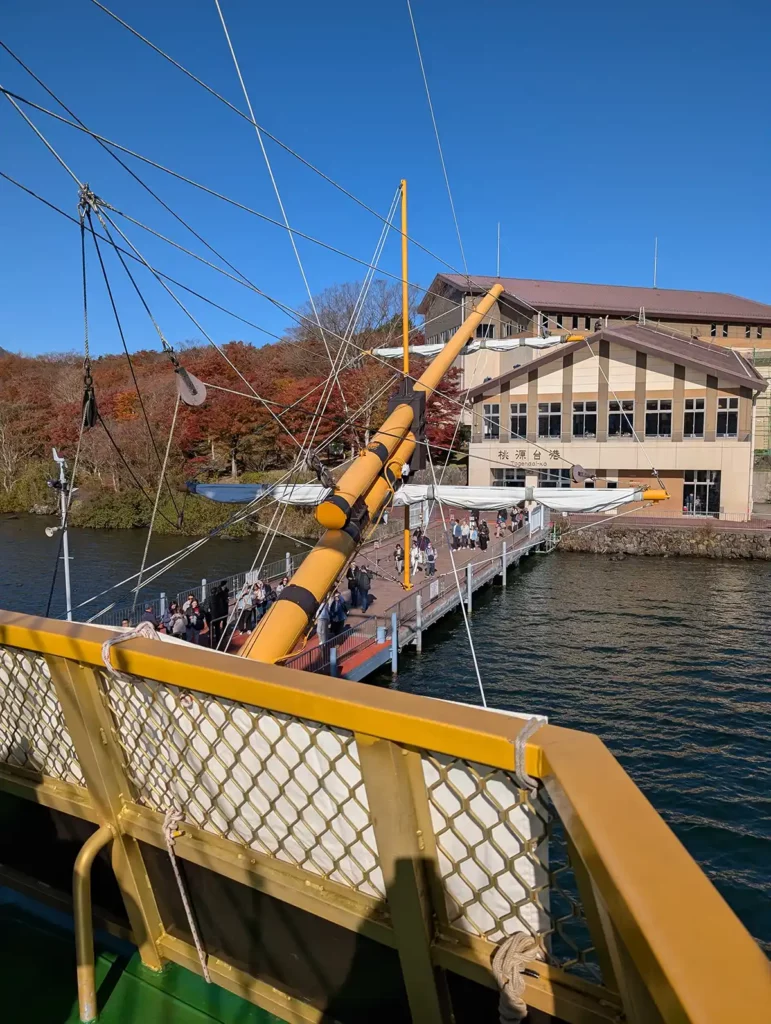
Things to do in Tōgendai
Hakone Visitor Centre
The Hakone Visitor Centre is around 10 minutes’ walk from the pirate ship port at Tōgendai. Inside, you’ll find displays on the local area’s history, geography and nature, with plenty of information available in English. There’s also a cafe with nice views over the lake.
Tōgendai to Owakudani by ropeway
When the pirate ship docks at Tōgendai, if you want to continue straight to the next part of the Hakone loop, all you have to do is go upstairs to the ropeway station.
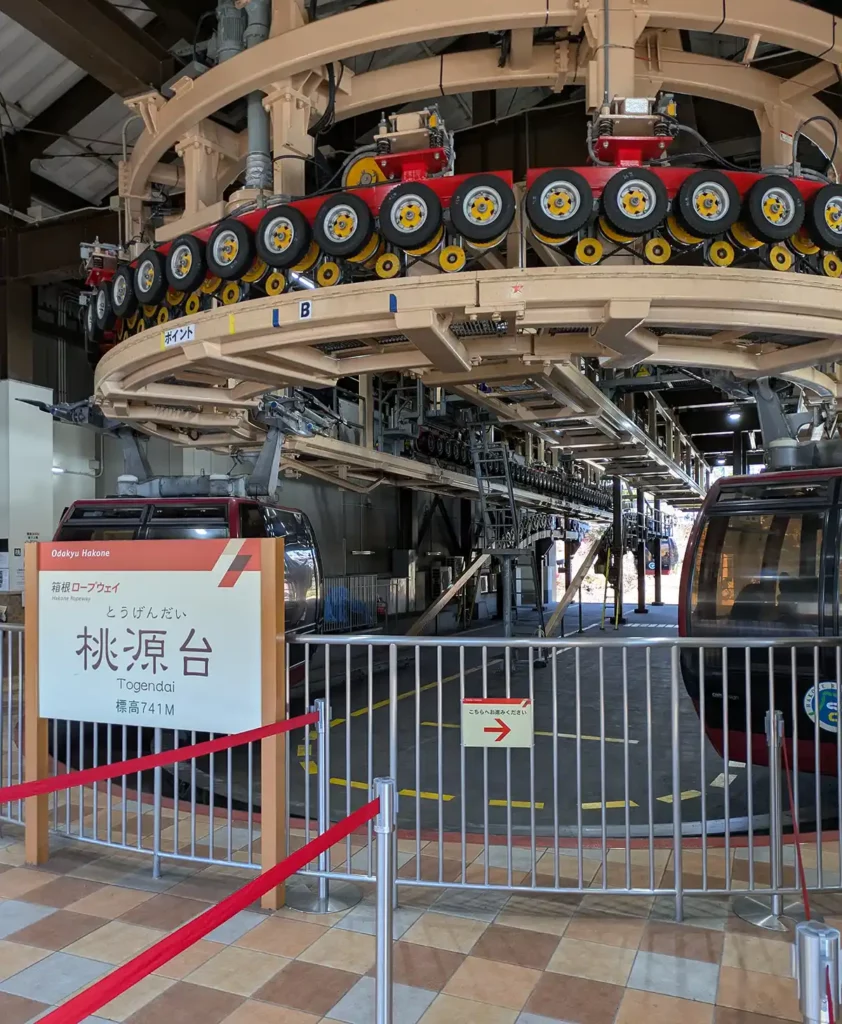
I found the term “ropeway” quite confusing – here in the UK we’d probably call it a cable car. The Tōgendai to Owakudani ropeway takes you up the mountain towards the active volcanic zone and steaming sulphur fields at Owakudani. If you’re lucky, there are views of Mount Fuji on the way.
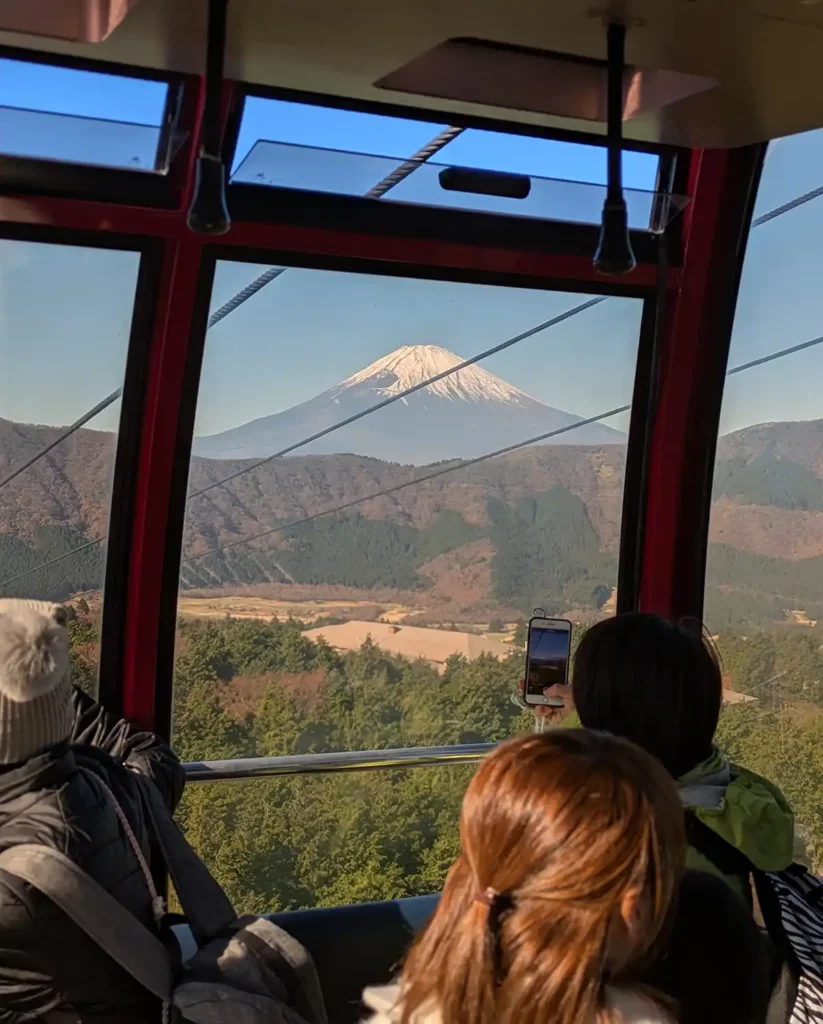
The Hakone Free Pass is valid for the ropeway, so if you’ve bought a pass, there’s nothing more to pay. There was a small queue to get on the ropeway, but we were on our way within a few minutes.
There’s a station part-way up, Ubako Station, but unless you’re staying at one of the onsen hotels in the area or visiting the Shumeikan hot spring, there’s no reason to get off before you get to Owakudani.
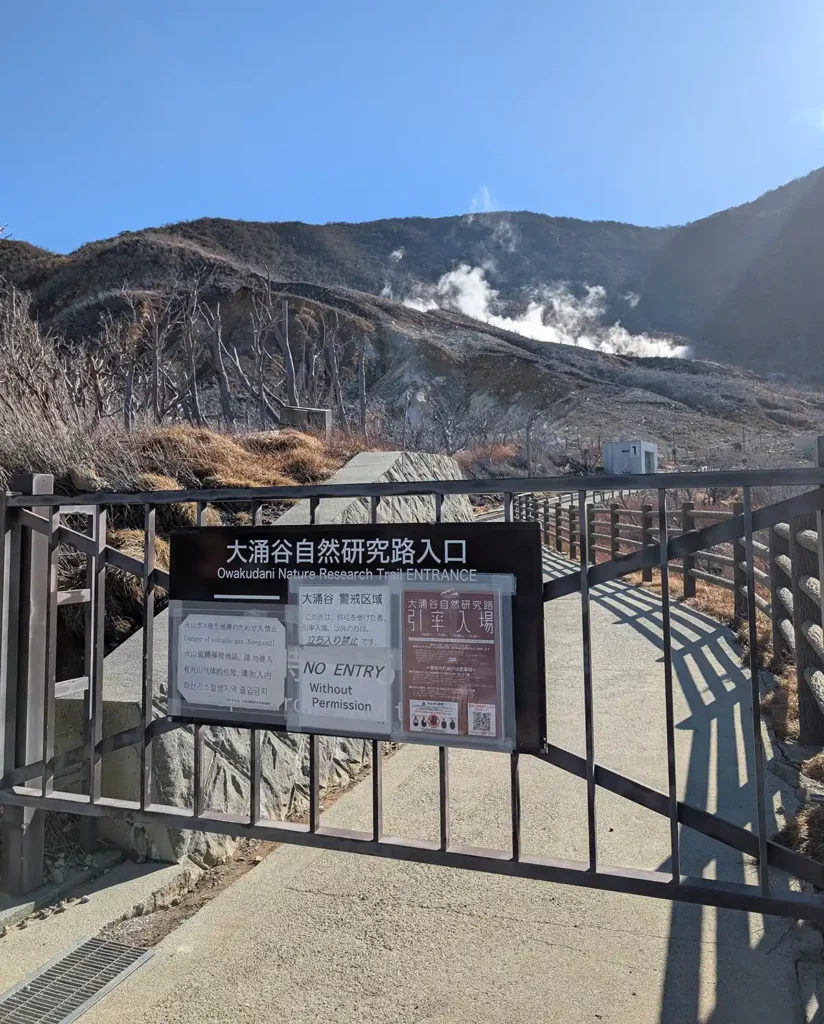
Things to do in Owakudani
Eat a black egg
Owakudani is famous for its black eggs. These are hard boiled chicken eggs that have been cooked in hot spring water from the mountain then steamed. The spring water that they’ve been cooked in contains sulphur and iron, which turns the shells black but leaves the inside white and yellow, just like a normal boiled egg.
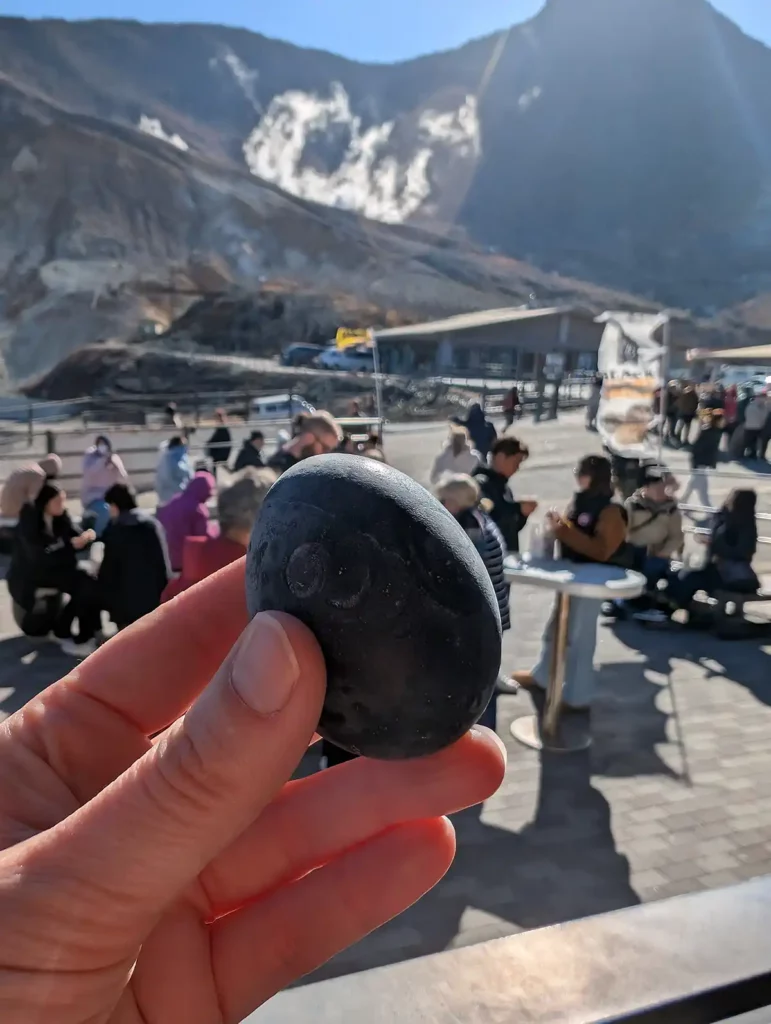
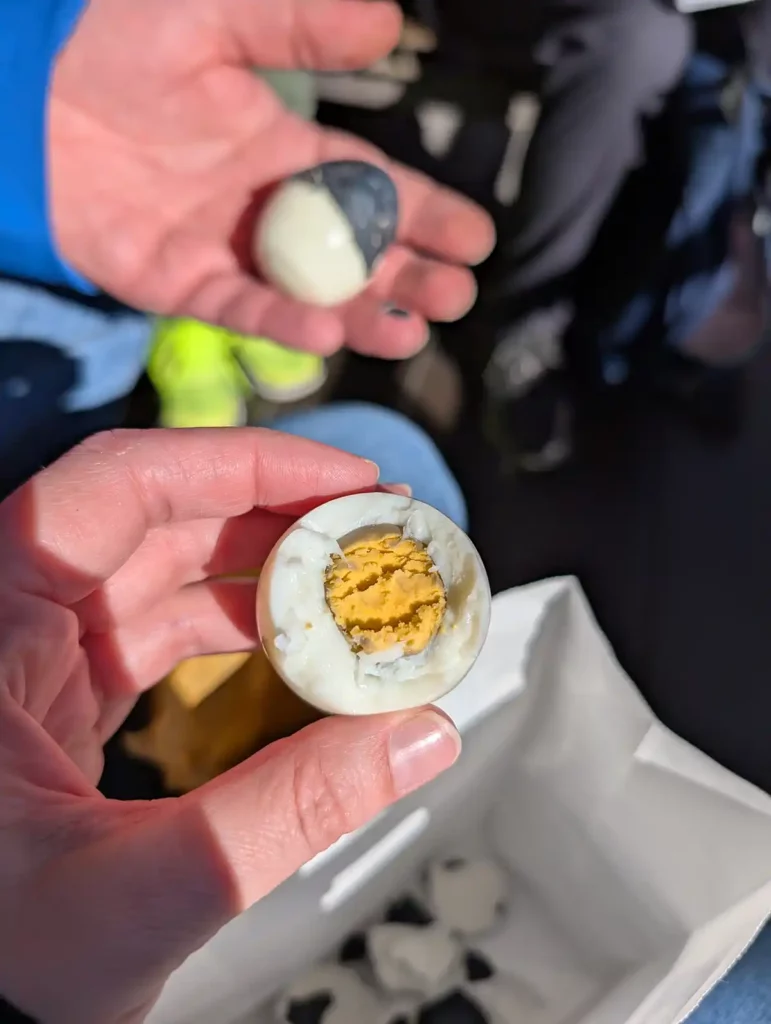
They taste just the same as normal boiled eggs, although the shells smell a little sulphury. They look weird, but they’re perfectly safe, and eating one is believed to add 7 years to your life. You can buy them in packs of 4 from a special desk in the souvenir shop next to the ropeway station.
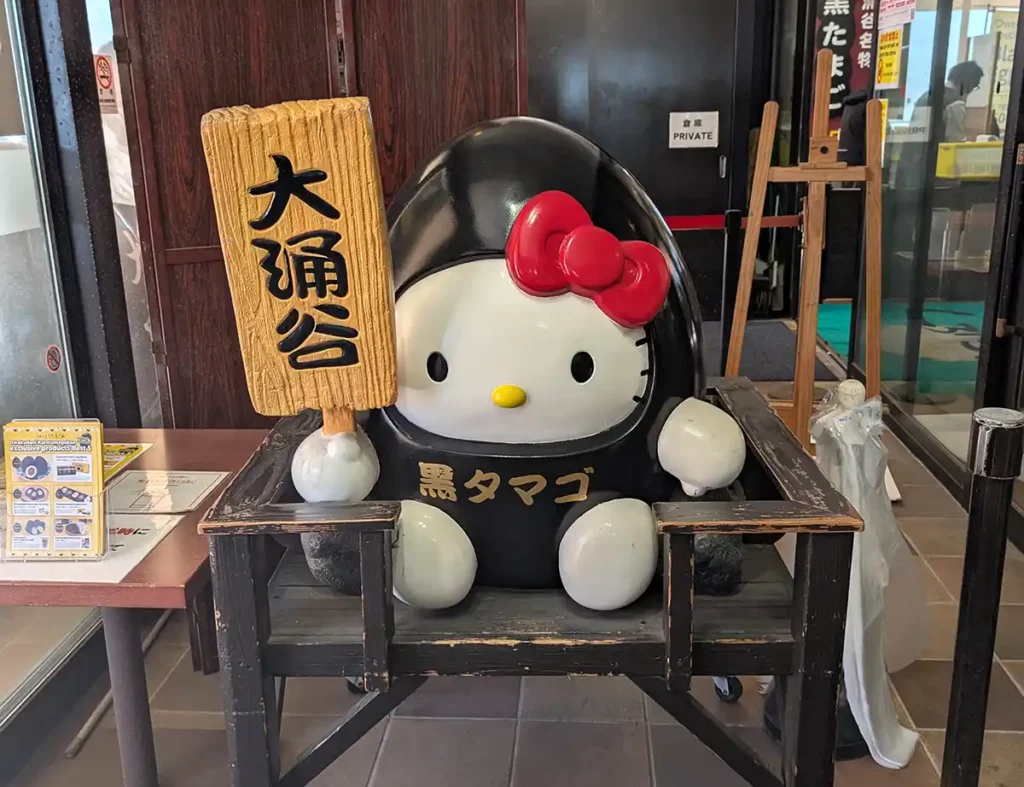
Because the black eggs are so famous, there’s lots of other black egg-themed stuff around the ropeway station. There’s a big black egg sculpture that you can have your photo taken next to, a figure of Hello Kitty with a black egg, and loads of black-themed goodies, including black egg ice cream and cakes.
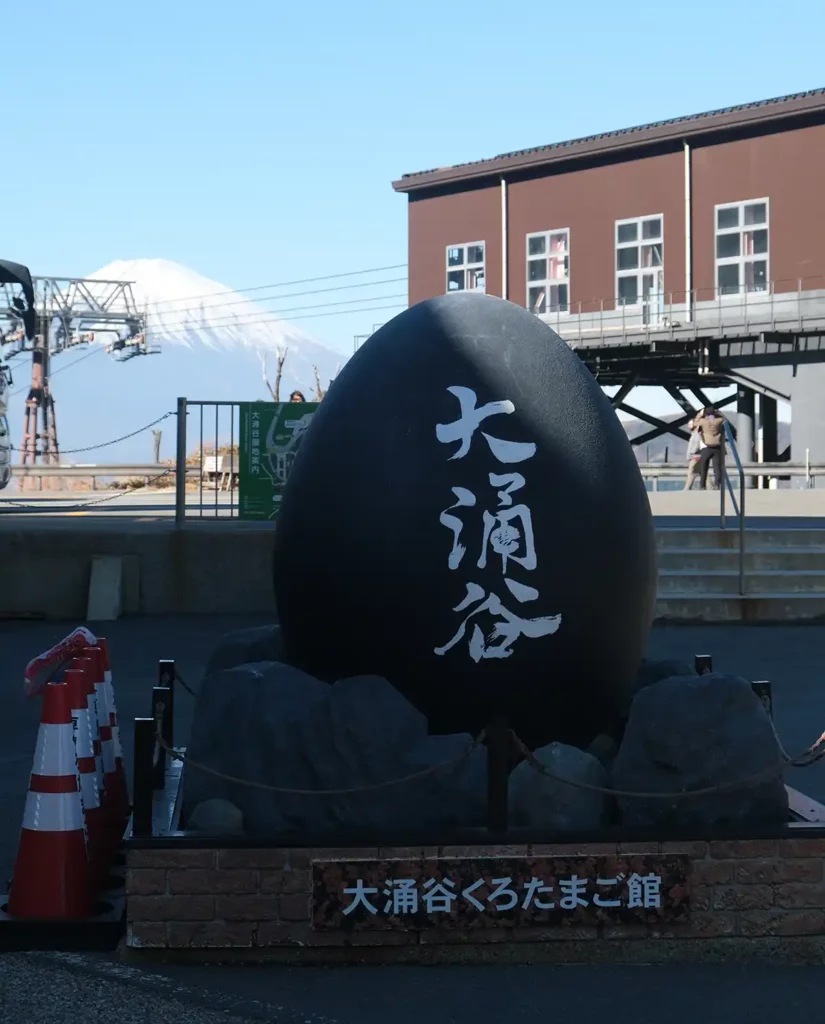
See the volcanic sulphur vents
As you approach Owakudani, you’ll see steam rising from the mountain from sulphur vents, a sign of the intense volcanic activity beneath your feet. There are warning signs everywhere telling you what to do if there’s an eruption but it’s very closely monitored so don’t worry too much!
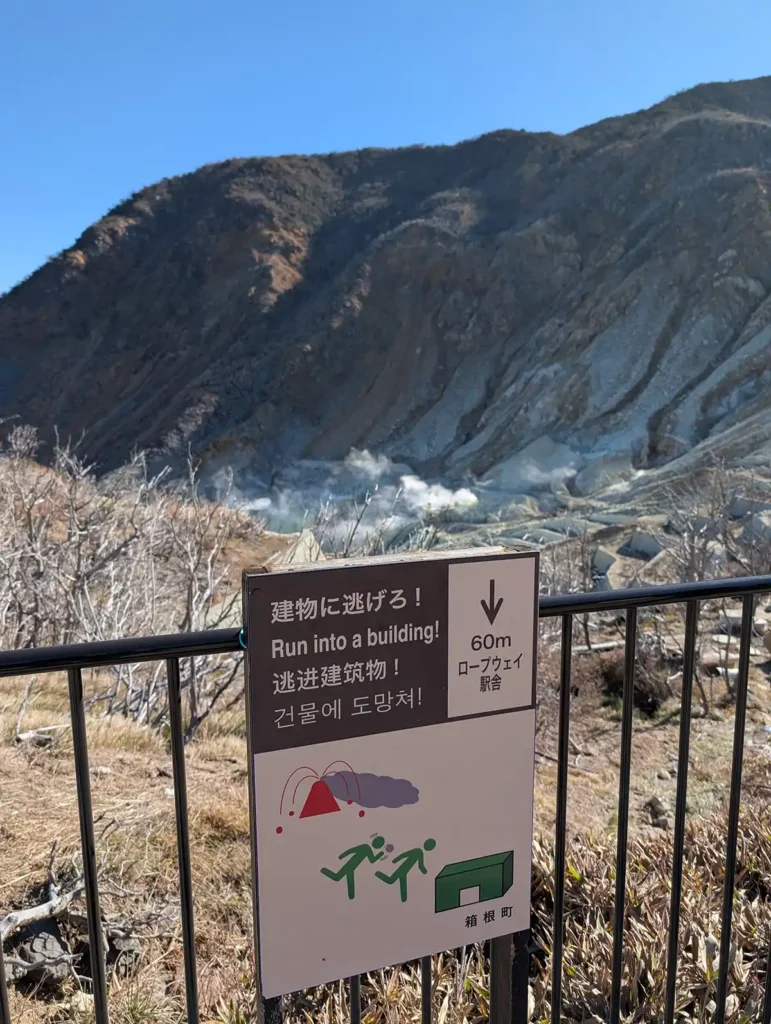
It used to be possible to walk close to the steaming vents, but the level of volcanic activity means it’s too dangerous at the moment. There is a guided walk that you can take (online booking is essential) but even that had been suspended when I visited!
If you’re pregnant, or have asthma, bronchitis, heart disease or a pacemaker, you’re advised not to enter the valley or take the ropeway across.
Enjoy the view of Mount Fuji
Owakudani is another great place to see Mount Fuji when the weather is clear, both on the ropeway up to the valley and from the visitor centre at the top. If you have your photo taken by the black egg, you can get Fuji in the background, and there are more great views from the car park.
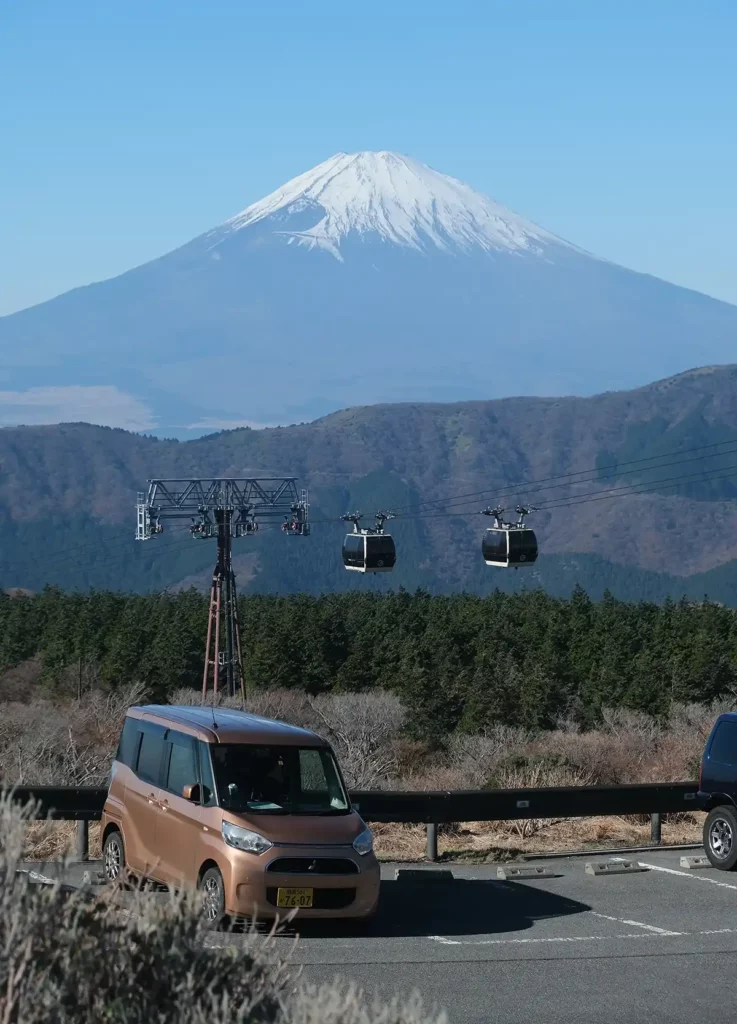
Owakudani to Sōunzan Station by ropeway
From Owakudani, to continue your journey clockwise on the Hakone sightseeing loop, take another ropeway towards Sōunzan Station. This ropeway takes you directly over the Owakudani valley and multiple sulphur vents – it’s an amazing sight, like being on another planet.
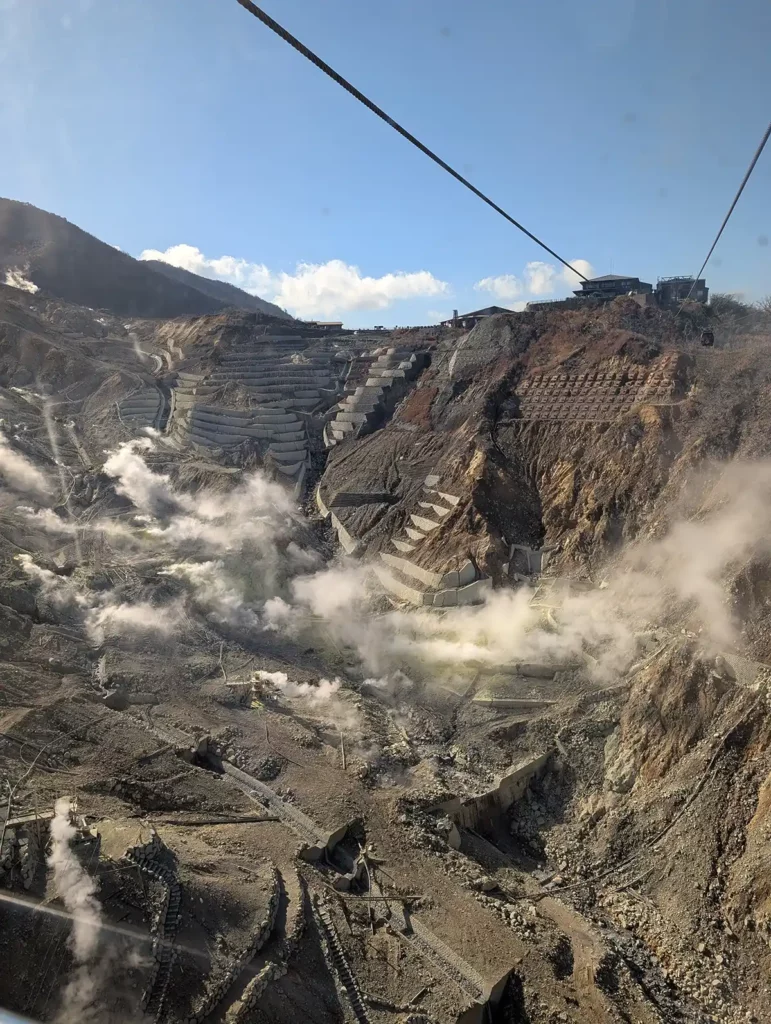
There’s a strong smell of sulphur and the air feels quite thin as you glide over the otherworldly landscape; if you start to feel light-headed or short of breath, each ropeway gondola has a plastic tub in the corner filled with oxygen canisters.
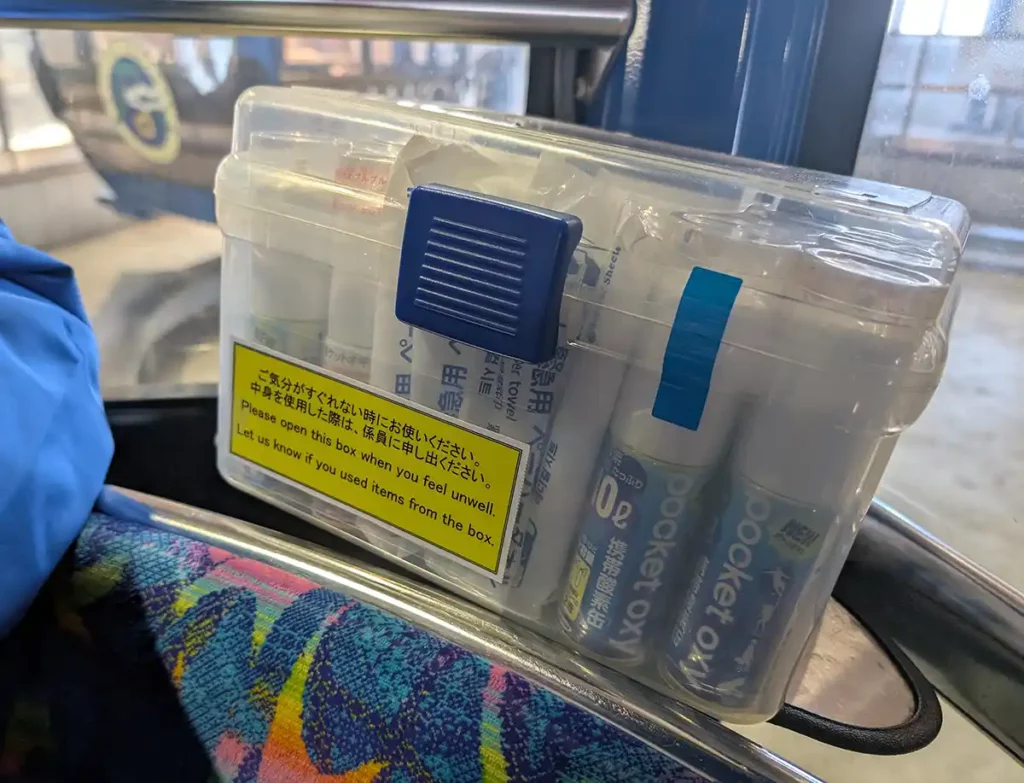
Things to do at Sōunzan Station
Shop for souvenirs
Sōunzan Station has a really nice souvenir shop, so if you have some time to wait before the next part of your journey on the Hakone loop I recommend checking out the shop inside the station. They also have a cafe counter with snacks, drinks and a range of craft beers from the Hakone area.
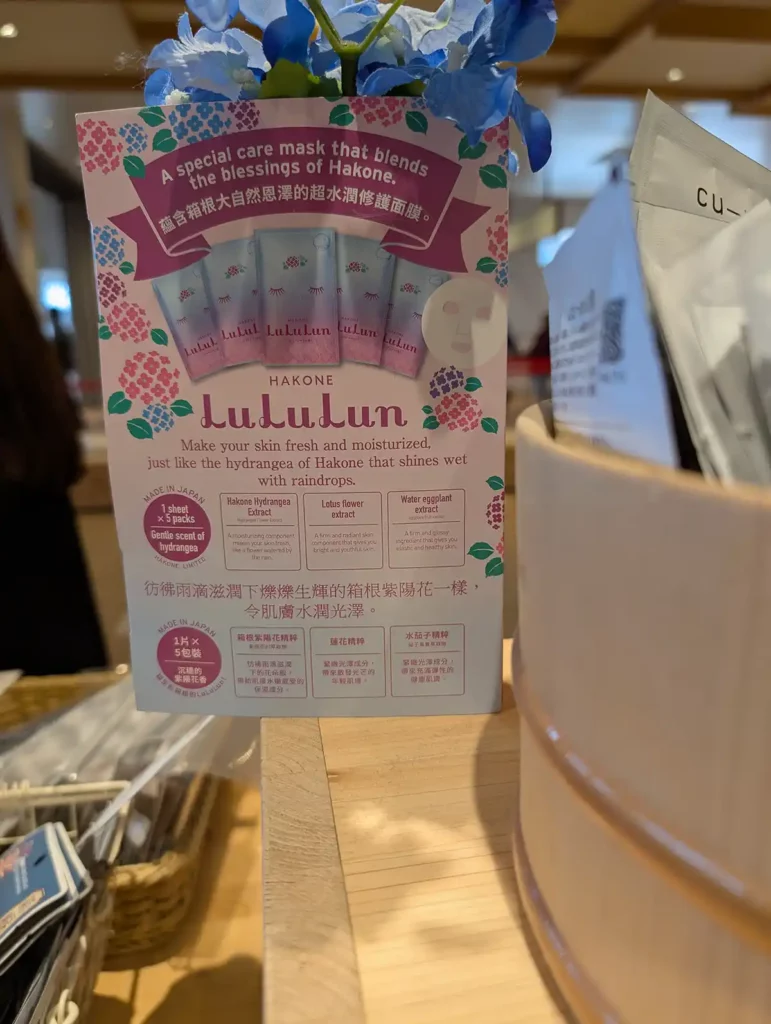
Take in the view from the foot bath
Sōunzan Station also has a lovely open air viewing deck where you can look down the thickly forested valley towards Gora. If your feet are starting to complain, you can sit and relax at the footbath.
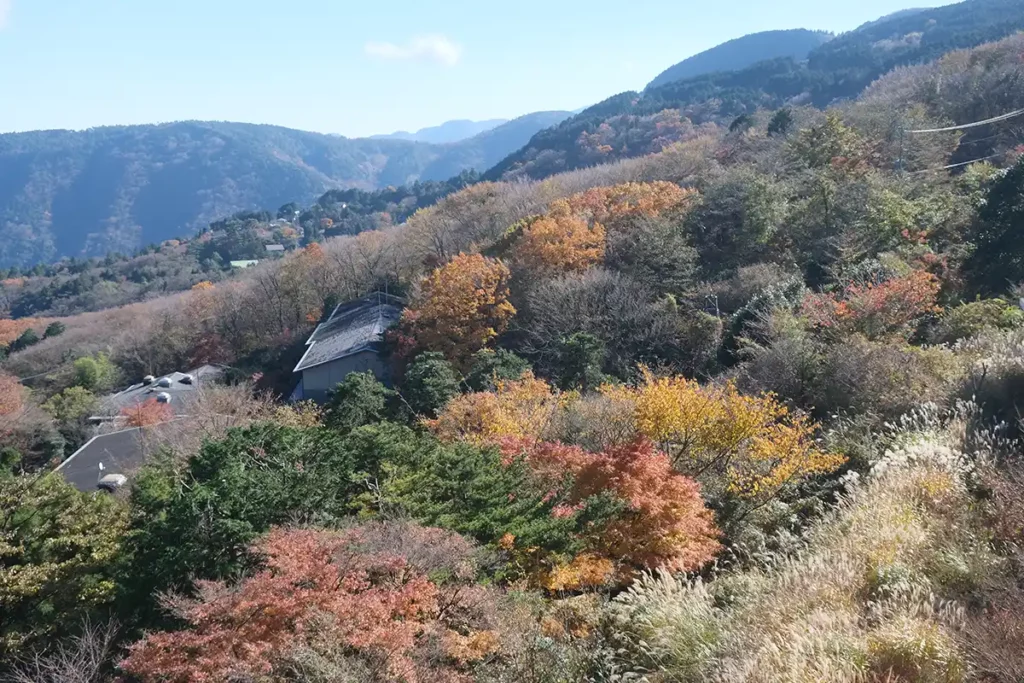
Sōunzan Station to Gora by cable car
From the ropeway and viewing platform at Sōunzan Station, head downstairs to the cable car platform towards Gora. I found the name cable car a little confusing as it’s what I’d call a funicular railway – a tram-like train with a driver which follows a steep, straight line from Sōunzan to Gora.
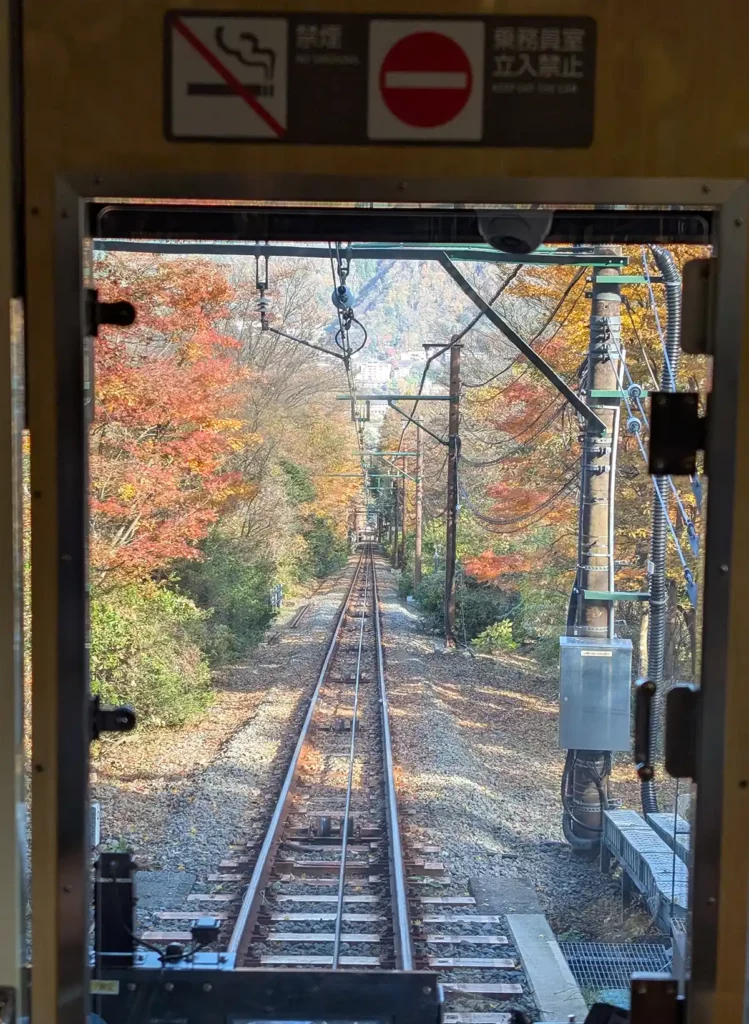
This part of the journey around the Hakone loop was the busiest; there’s quite a long wait between services and they get quite crowded.
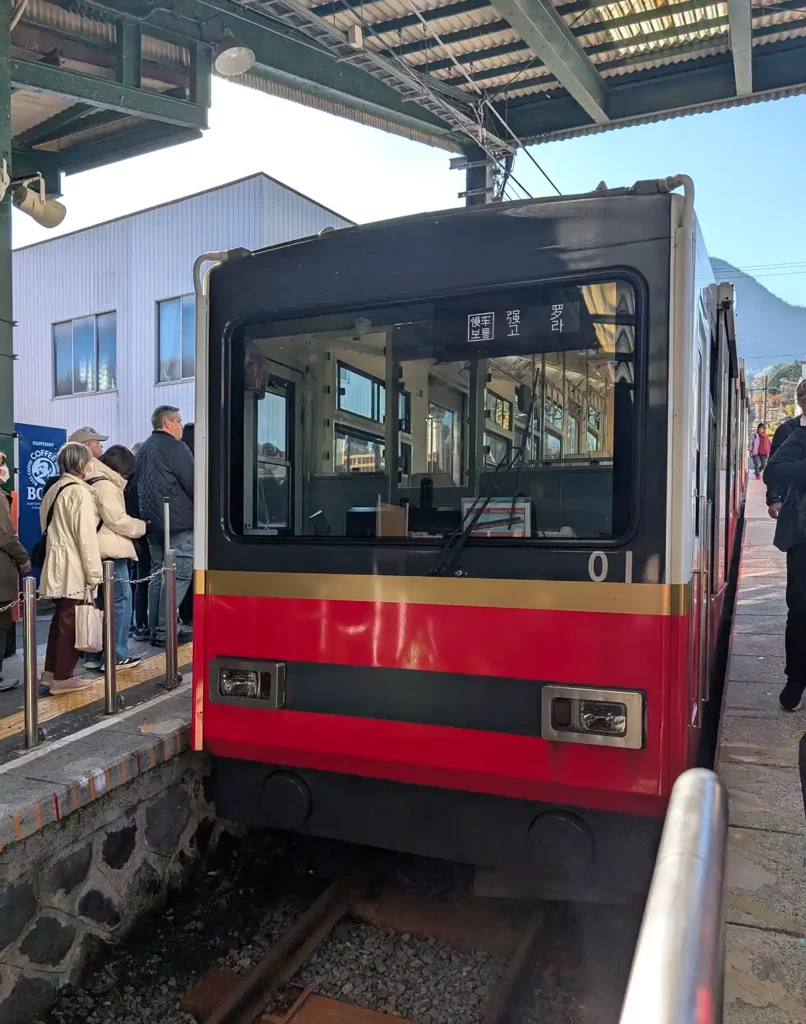
I was in Hakone in early December and there was some beautiful colours in the trees on this part of the journey, but because it was crowded it was difficult to get good views. If you have time, I’d recommend getting to the platform just as a train is leaving, so you can be one of the first onto the next train. For the best views, sit or stand at the very front of the train.
Things to do in Gora
Gora is a small town, but it’s the gateway to some of the Hakone area’s most popular attractions. Some are within walking distance of stations on either the cable car or Gora station, while others will need you to take a taxi or bus. Most buses around the Hakone area are covered by the Hakone Freepass.
Hakone Open-Air Museum
If you visit one museum on the Hakone Loop, make it the Hakone Open-Air Museum. The museum has a large sculpture park plus some indoor exhibits.
The highlight is the Symphonic Sculpture by French artist Gabriel Loire, a tower made of 480 sheets of brightly coloured stained glass with a spiral staircase at its centre. The nearest station is Chokoku-no-Mori Station on the Gora to Hakone-Yumoto train line, or it’s a 15 minute walk from Gora station.
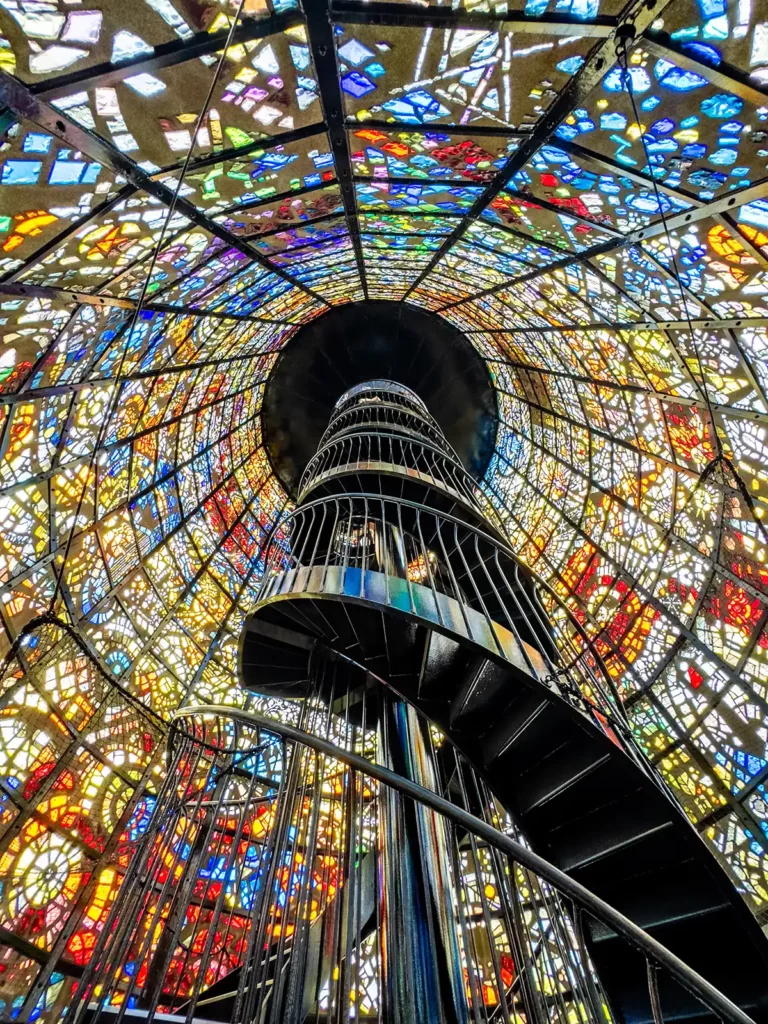
Hakone Museum of Art
The Hakone Museum of Art specialises in pottery, with small displays showcasing porcelain and other ceramics. Most visitors come for the museum’s stunning moss garden, which looks especially gorgeous in autumn. The nearest station is Koen-Kami Station on the Sōunzan Station to Gora cable car.
Hakone Gora Park
Hakone Gora Park is a beautiful French-style garden with a fountain, a rose garden and a greenhouse holding a collection of tropical herbs. There’s a café and a tea house where you can take part in a traditional Japanese tea ceremony. The nearest station is Koen-Shimo Station on the Sōunzan Station to Gora cable car.
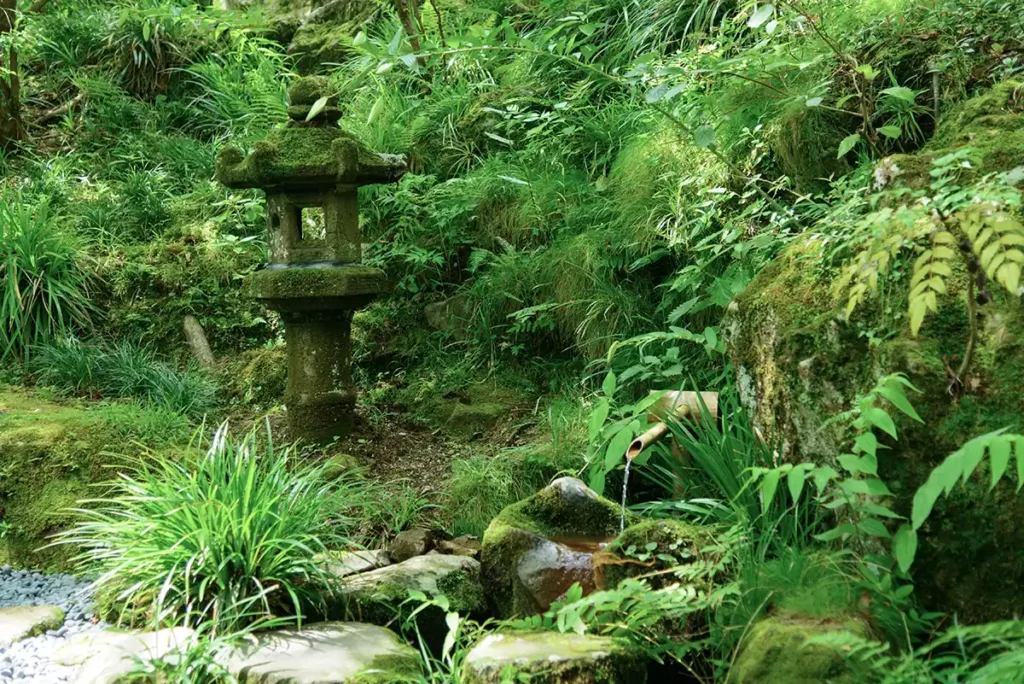
Hakone Museum of Photography
The Hakone Museum of Photography has a permanent collection of photos of Mount Fuji through the seasons along with temporary exhibitions. The museum offers regular Hakone photo walks and lectures. The nearest station is Koen-Shimo Station on the Sōunzan Station to Gora cable car.
Gora to Hakone-Yumoto by train
Along with the pirate ship and the ropeway over the volcano, the Hakone Tozan train from Gora Station to Hakone-Yumoto was one of my highlights of taking the Hakone loop.
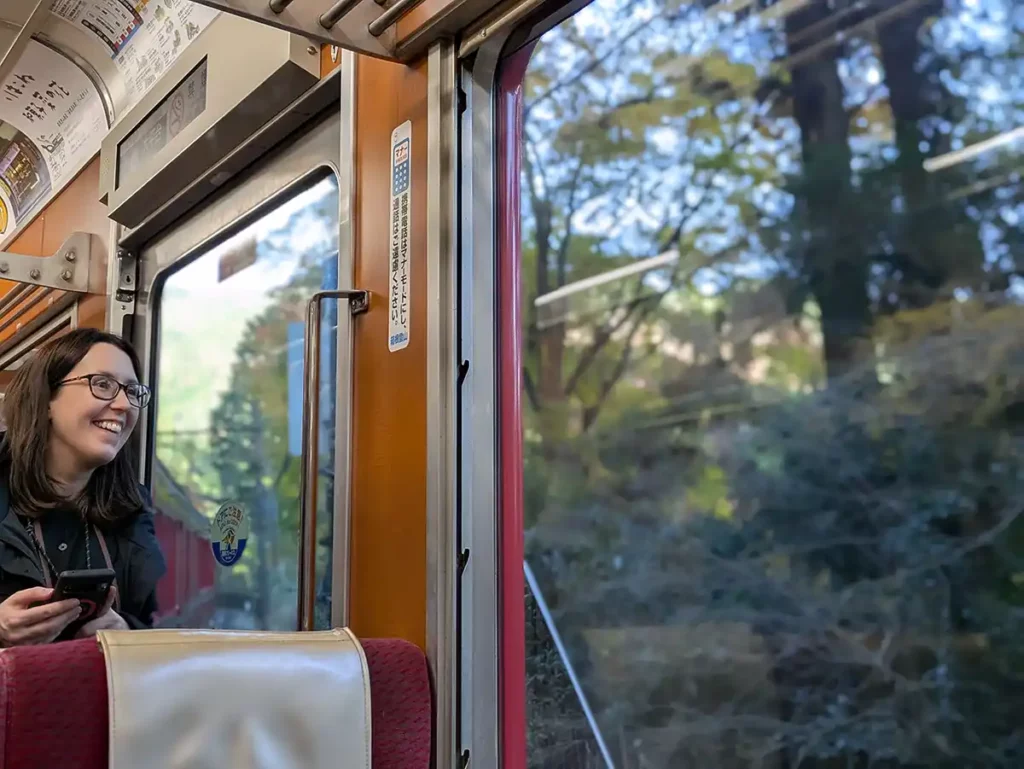
The train travels down steep inclines on its way to Hakone-Yumoto, through tunnels, across bridges, past little villages and shrines, and all through the most magical scenery. On my trip in early December, the autumn foliage was starting to appear, but in June and July the train’s route is lined with gorgeous hydrangeas.
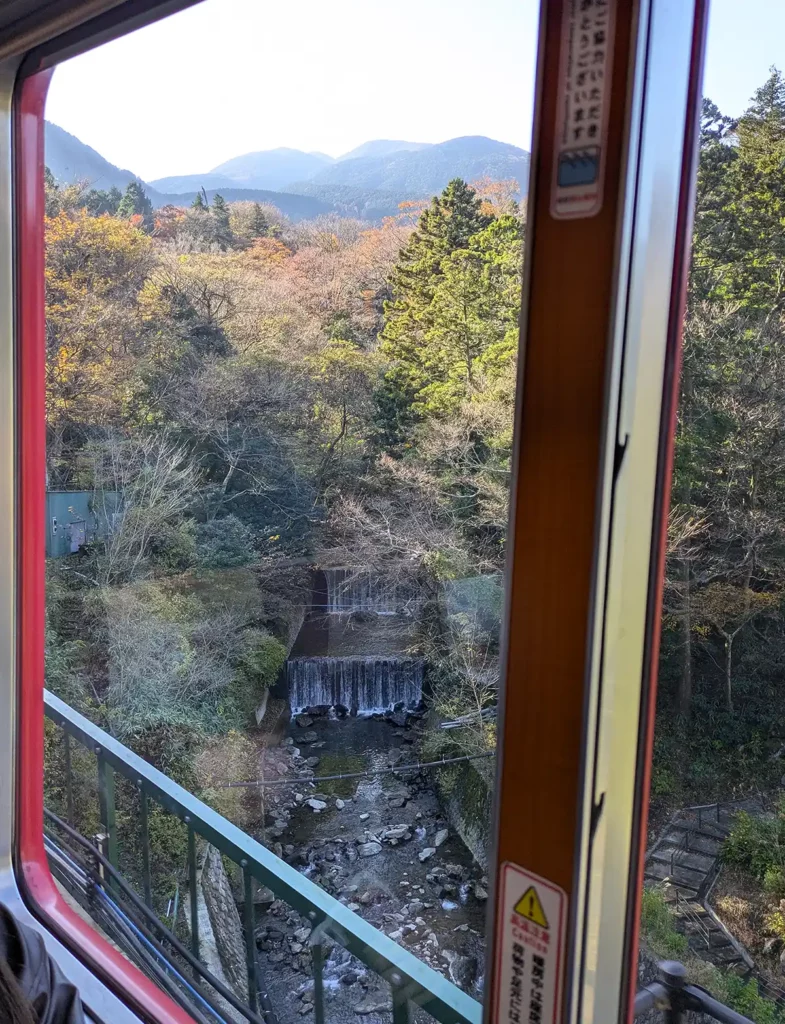
The line from Gora to Hakone-Yumoto is so steep that it needs to use switchbacks rather than curves to get down the mountain. I was delighted to see that this little red train was twinned with another scenic red train, the Bernina line in Switzerland.
The Hakone Tozan train I took was relatively busy, but the trains coming the other way from Hakone-Yumoto looked significantly busier – an advantage of taking the Hakone loop clockwise.
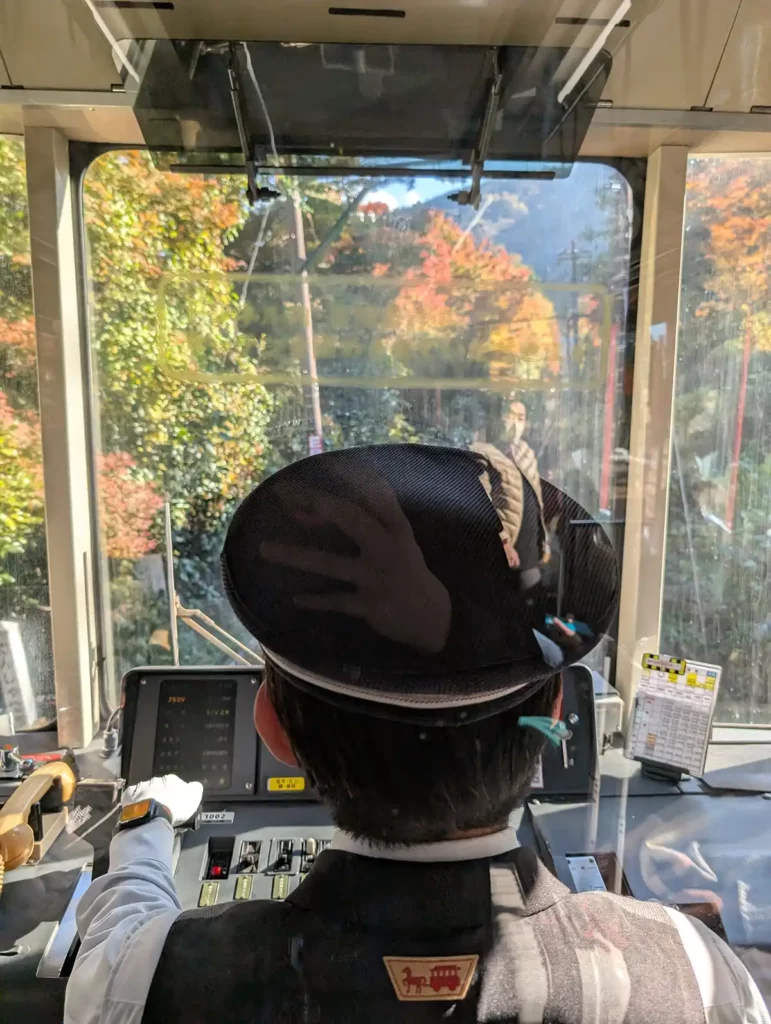
If you can, I recommend getting on the train at either the very front or the very back. There are a couple of seats right behind the driver’s cab on either end which have amazing views of the route – I wasn’t quick enough to get them but I did manage to get a good view by standing behind the cab.
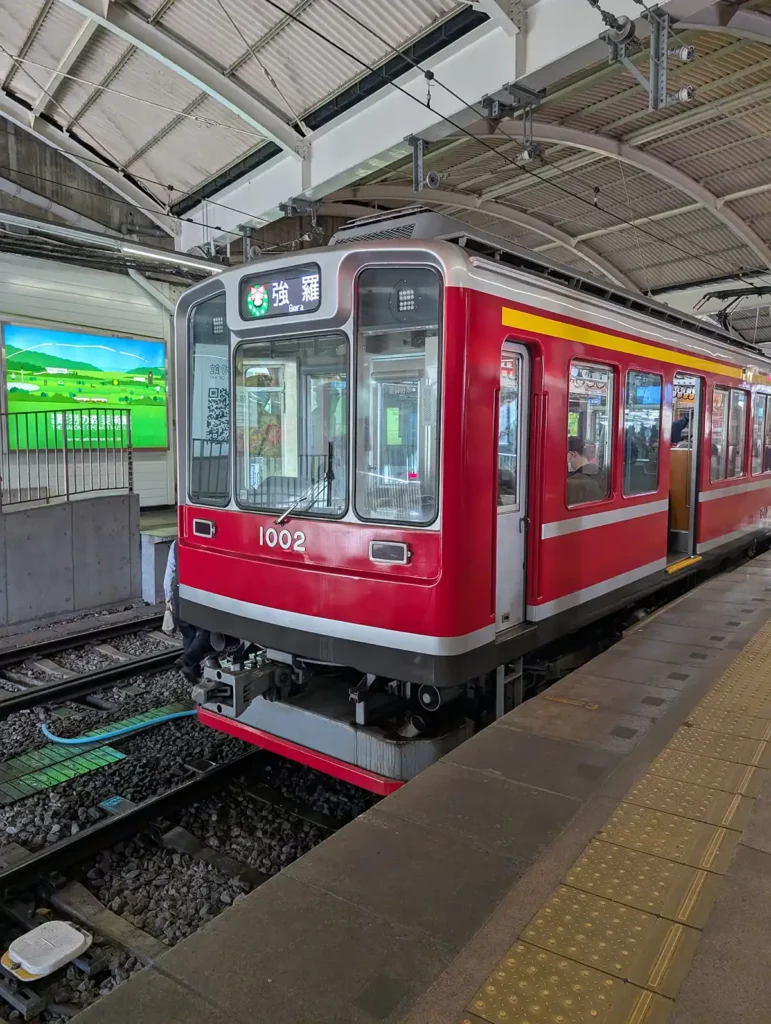
Things to do in Hakone-Yumoto
Go to a day onsen
I recommend staying overnight in Hakone if you have time, but if you only have one day and you want to try a hot spring bath in the mountains then there are several day onsen around Hakone-Yumoto. Visiting an onsen could be the perfect way to finish the Hakone loop before you return to Tokyo.
Hakone Yuryo is set in the forest and has public and private onsen; some indoor and some in the open air. There’s a free shuttle bus to and from Hakone-Yumoto station.
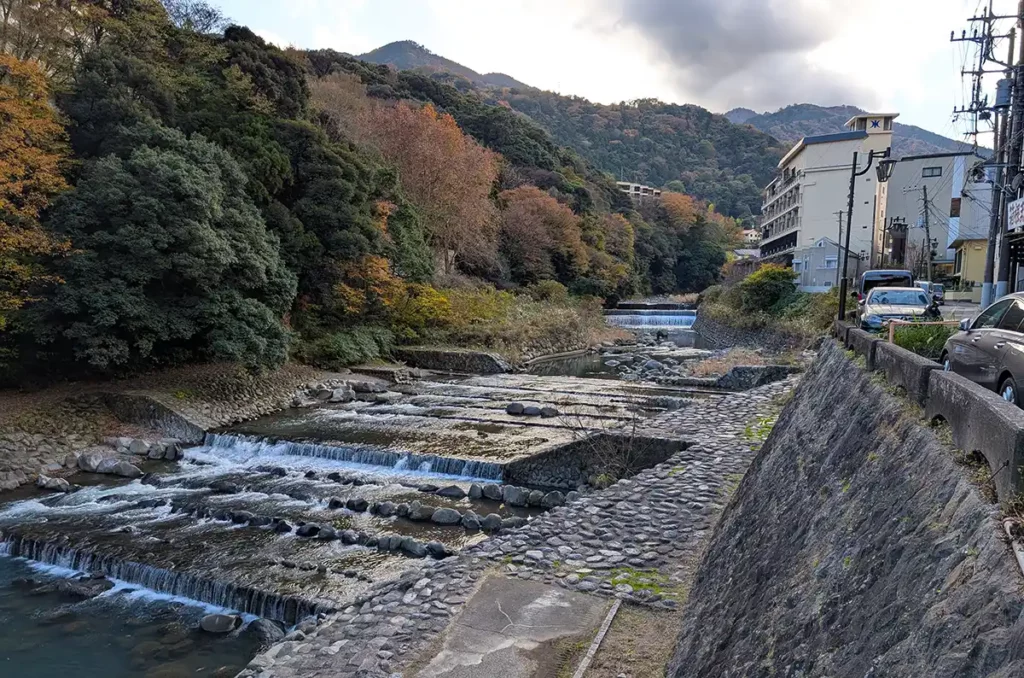
Kappa Tengoku is right by the train station and has a natural open air onsen and an indoor private bath, fed by two natural hot springs.
Yumoto Fujiya Hotel has open air baths which are available for day use, plus private onsen rooms which you can book in advance. The hotel is 4 minutes’ walk from the train station.
Shop for souvenirs
Hakone-Yumoto is the busiest town I saw in Hakone. The main road through the town is lined with restaurants, places to get snacks and souvenir shops, and I was able to pick up some nice gifts that were different to the ones available in Tokyo.
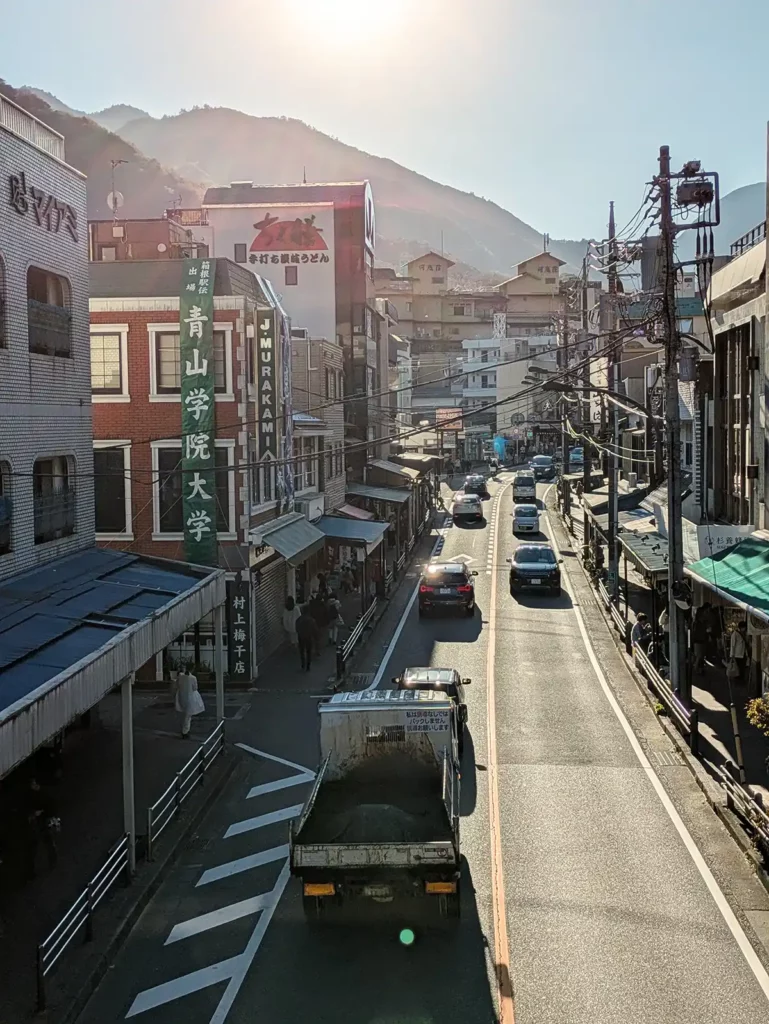
Summary: is a trip to Hakone worth it?
Even though I only had a week in Japan, I don’t regret spending two days of it in Hakone at all. It is touristy and busy, but that’s ok – it’s so cool that it would be strange if more people didn’t want to see it!
When I was planning my trip I found the sightseeing loop quite difficult to understand, but in practice it was really easy. Each connection was simple to find, and we were never waiting around too long for the next bus, train or pirate ship. I do think it was a little quieter to do the Hakone loop clockwise, travelling first to Motohakone and Lake Ashi rather than taking the train up to Gora.
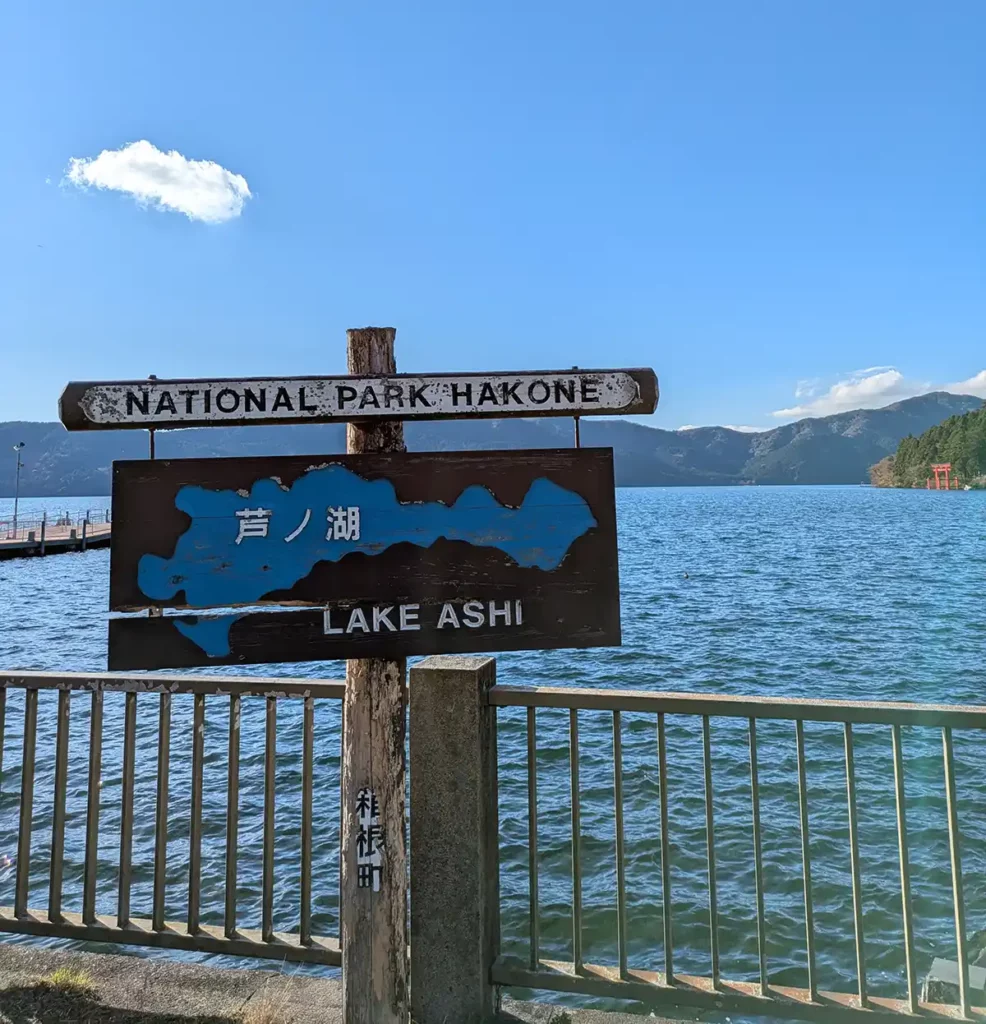
The whole trip reminded me a lot of Norway in a Nutshell, another self-guided day trip with lots of forms of transport. If you’re planning to visit Hakone I highly recommend buying a Hakone Freepass – it makes the whole trip so easy with no need for extra tickets to get around.
If you’re looking for an easy day trip or side trip from Tokyo, then Hakone is a great choice. The Hakone loop is a brilliant way to see some amazing sights and have incredible experiences in just a day or two, and gives a wonderful contrast to the big city.
Would you visit Hakone? Let me know in the comments if you have any questions!


Absolutely amazing blog, thank you for taking the time! Have taken notes for my upcoming trip.
Thanks Callum, I’m glad it was helpful. Let me know if you have any other questions 🙂
Lovely post! Thank you for sharing. Love the details and the photos. I might try the black eggs if I visit Hakone.
Thanks Oz, I hope it ends up being useful for you!
Hello. Your tips are great, and we’ll be adopting the clockwise approach. We are travelling in June and given the poor weather we expect + our budget, we are looking at just a day trip in Hakone on the free pass.
How long do you think it takes to do the loop? We have already discounted stopping at the Lake Ashi shrine tori gate as neither of us are partial to lining up. We had seen some craft things that take our interest more.
Our plan is either a 7:30am or 9:30am Romancecar from Shinjuku. Do the Hakone loop, check some local crafts (glass, specifically), and grab the Shinkansen from Odawara to Kyoto in the evening. Do you know if that would be doable? Everything I’ve been able to find all talks about going back to Tokyo as a round-trip, rather than heading south.
Thanks in advance.
Hi Kate, yes I think that’s doable, there are quite a few Shinkansen heading south and it’s less than 3 hours to Kyoto, only just over 2 if you can get a faster Shinkansen. I’d be tempted to try for the earlier Romancecar if you can bear the early start though! What were you planning to do about luggage? There is very limited luggage storage at Hakone-Yumoto station so Odawara might be a better bet for finding a locker.
You can still see the Lake Ashi shrine without lining up, the queue was just to get a picture with it. It is a lovely spot but you’ll also see it from the pirate ship.
Have you seen the Craft House in Gora park? The activities look great https://www.crafthouse.org/en/information.html
Thanks for rich information. I plan to visit Hakone, but most of information are in Japanese. Your page is awesome!
Thanks Kahn, I hope it ends up being helpful!